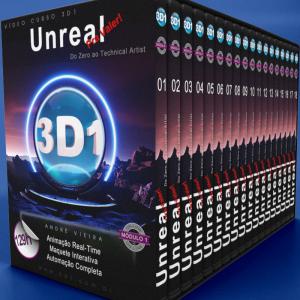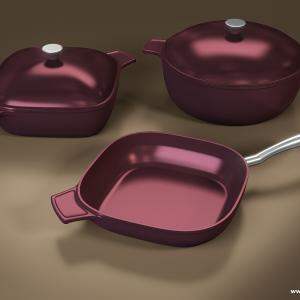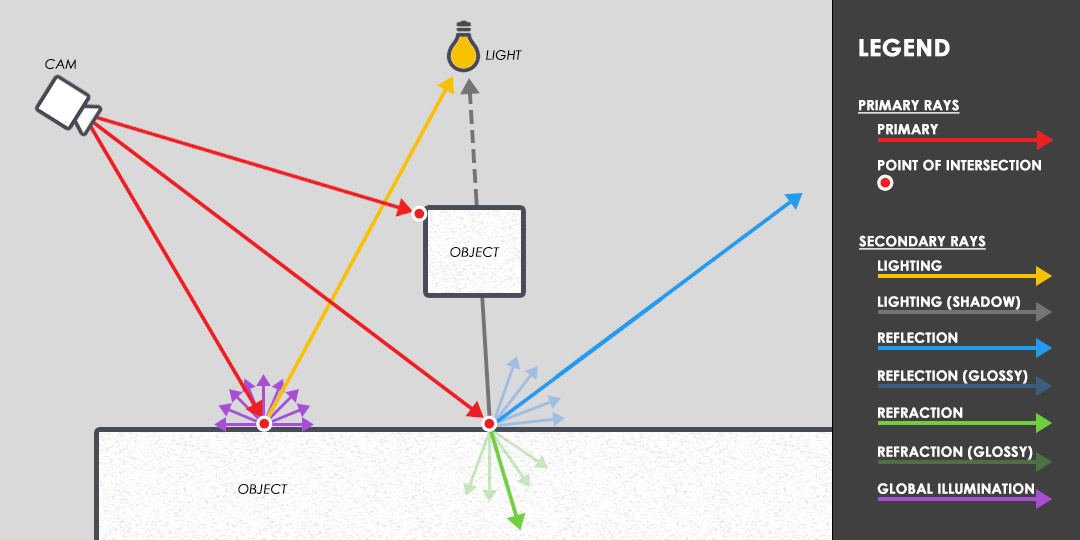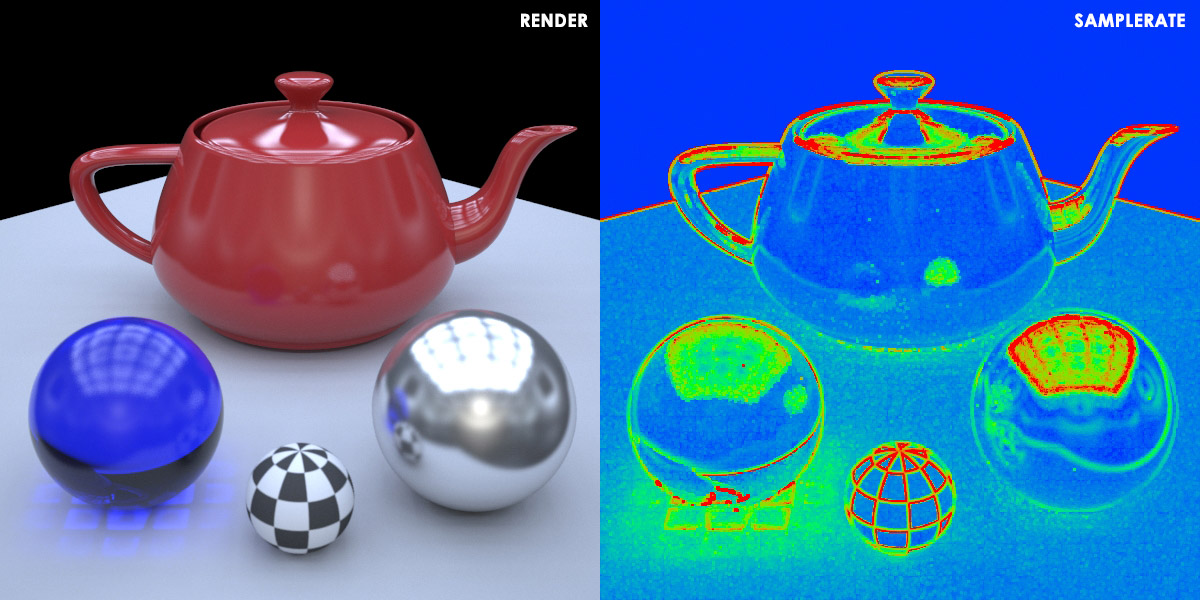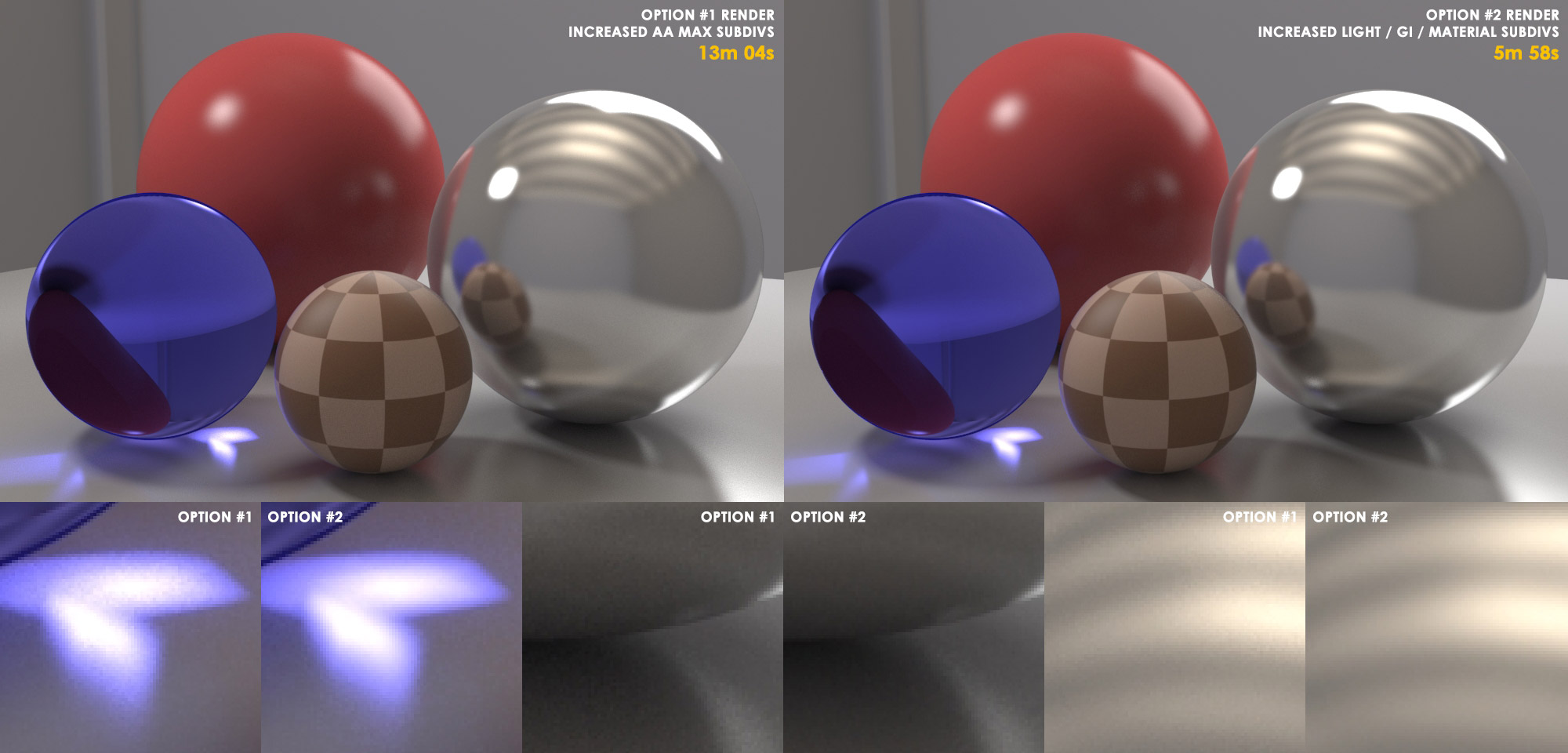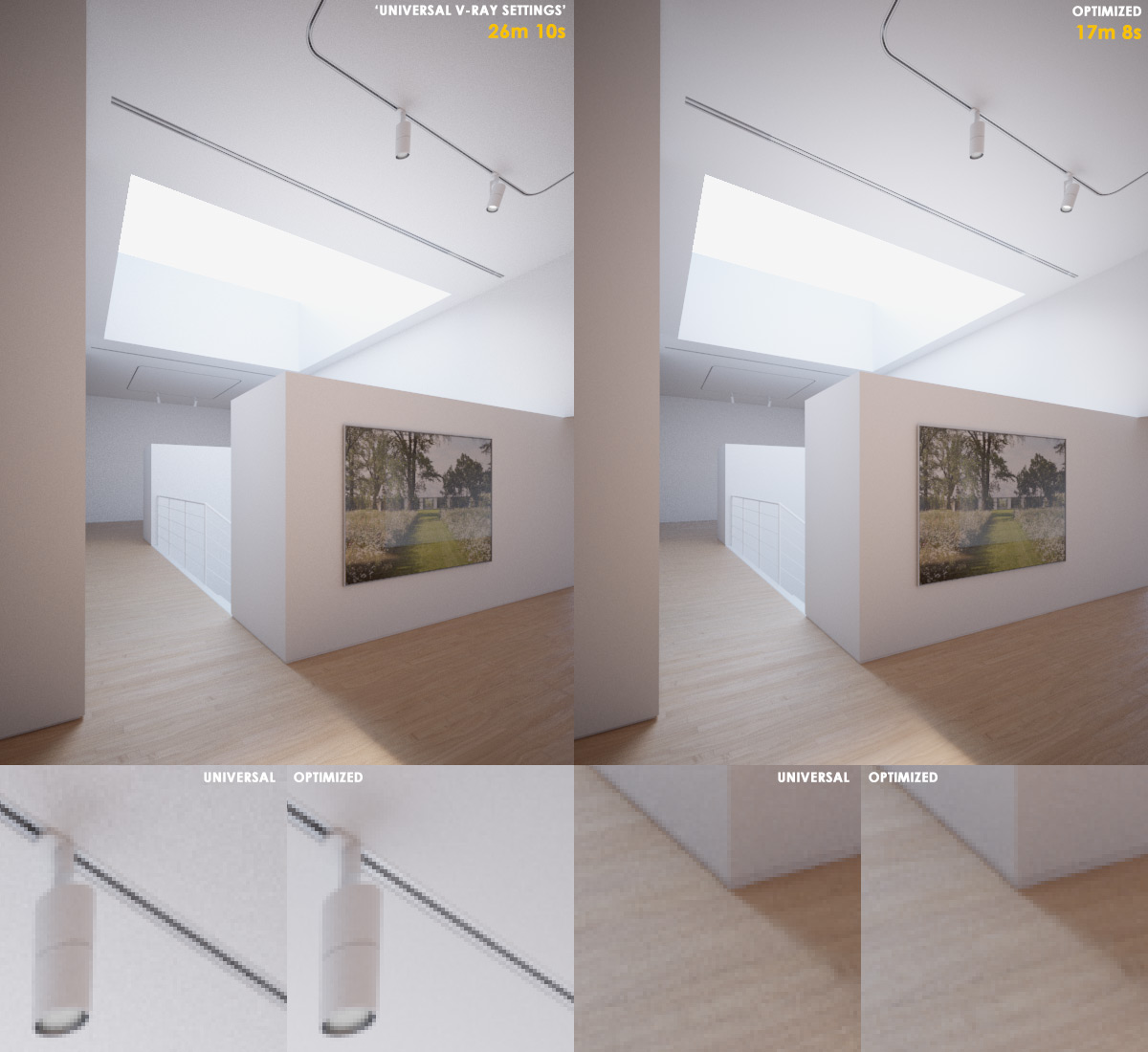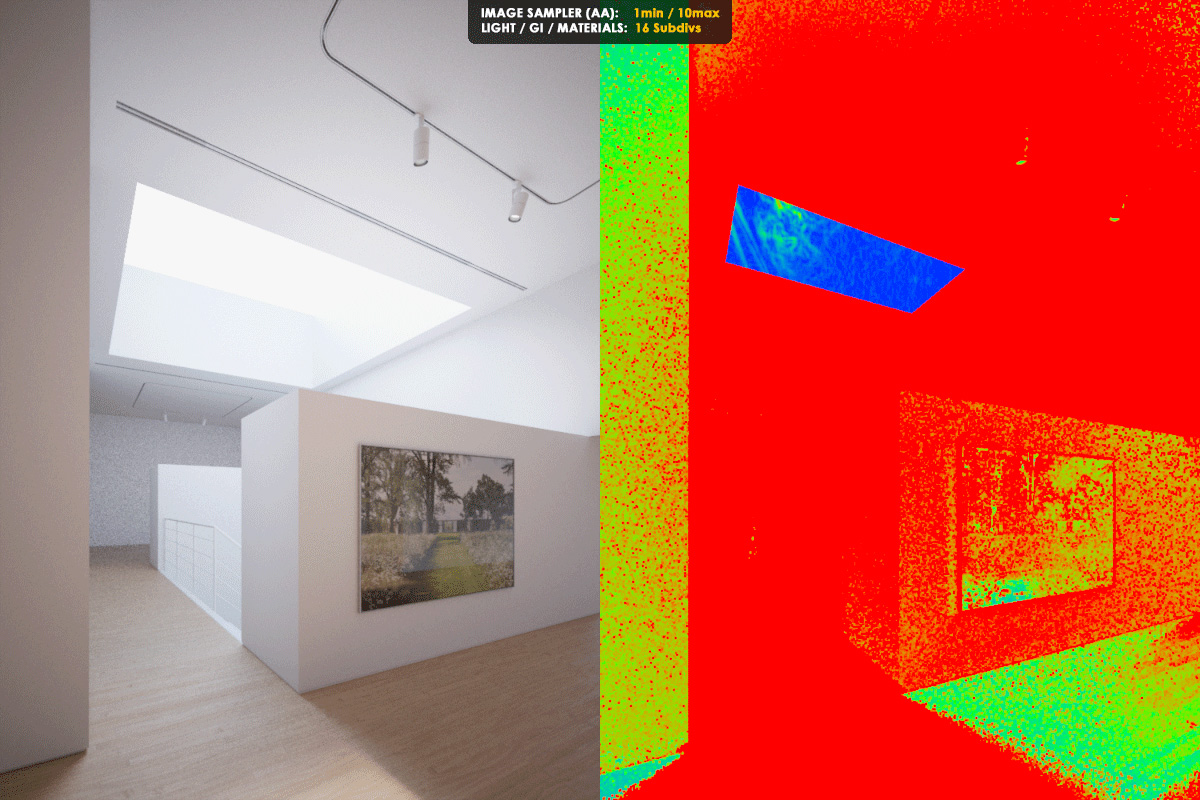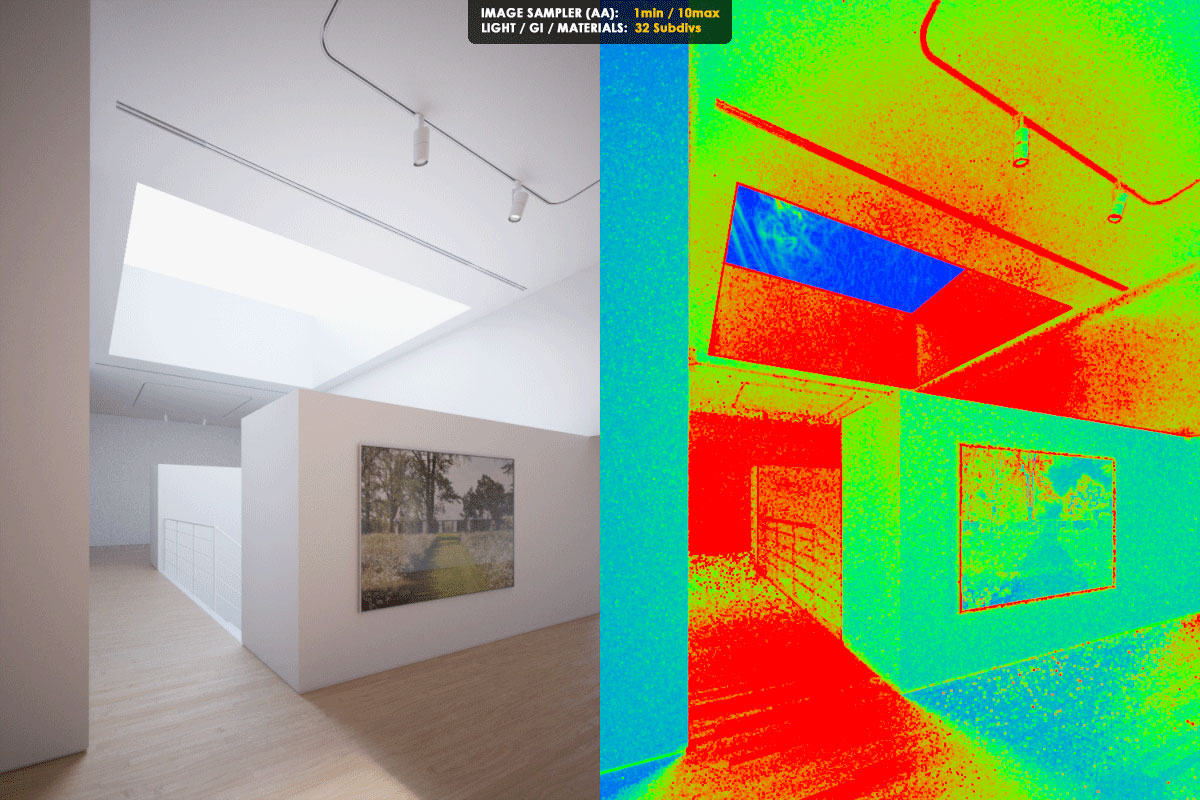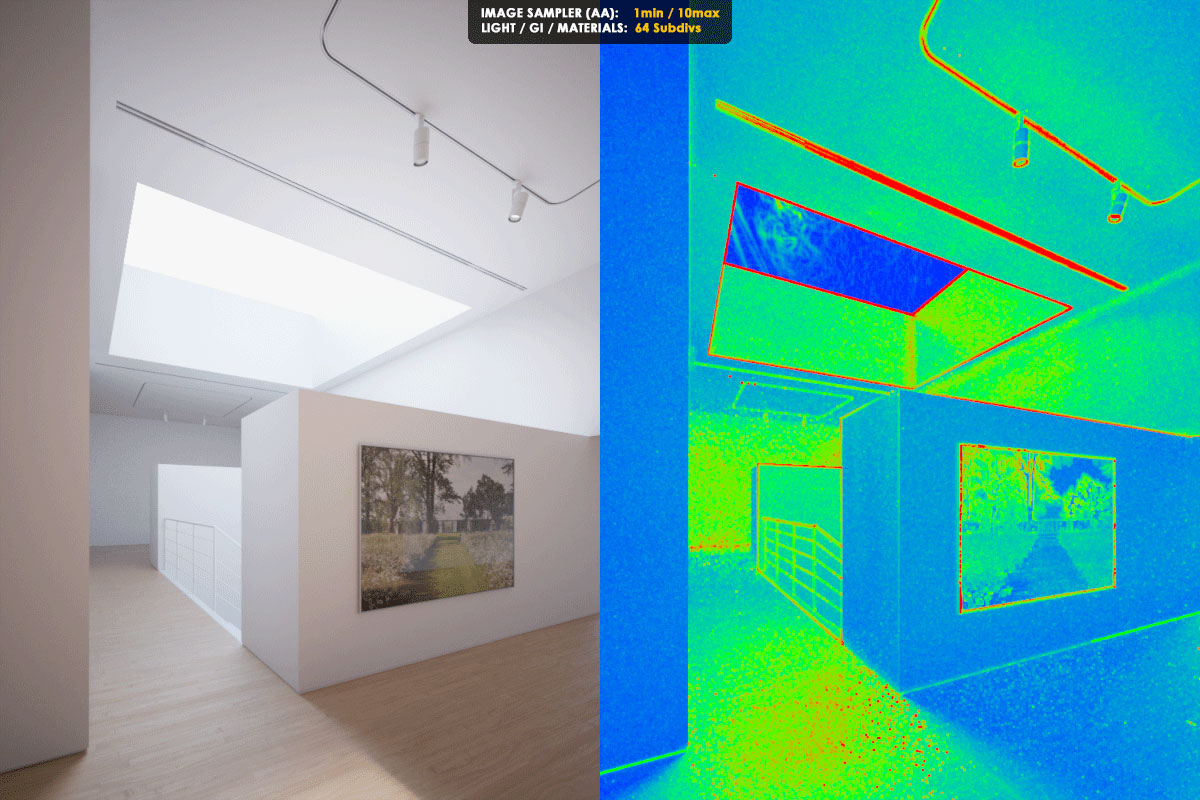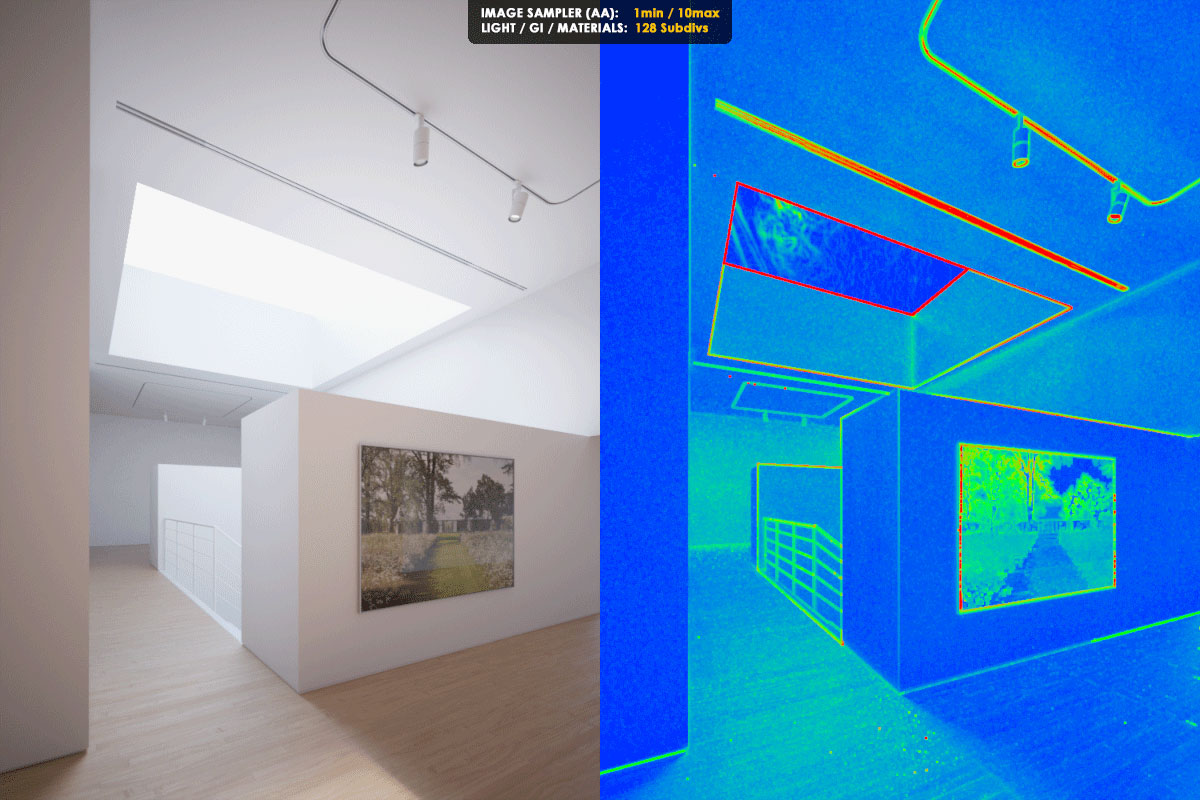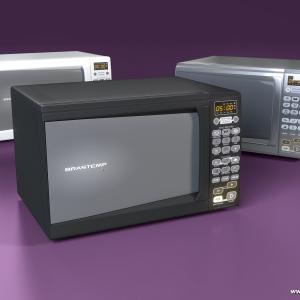Cursos e Bibliotecas Ver Mais
Galeria 3D1 Ver Mais
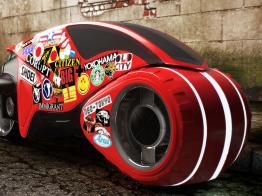
ronaldo.n2008
Bento Gonçalves - RS
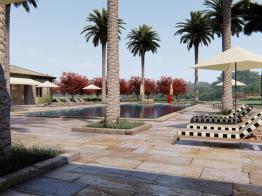
gilson antunes
Curitiba - Brasil - PR

Andre Bittencourt
Rio de Janeiro - RJ

Lucas
Brasil - SP
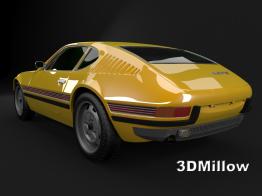
Millow
São Paulo - AC
Portfólios Ver Mais
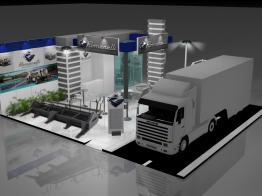
alexarantes
Rio de Janeiro
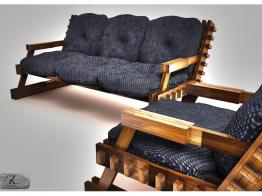
kunzlerdesign
BRASIL

DanielMaia
João Pessoa - PB
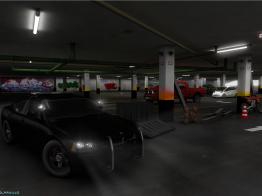
rafaelsampaio
São Paulo
Tutoriais - Todos os tutoriais
Tutorial original --- http://www.cggallery.com/tutorials/vray_optimization/
INTRO
In this tutorial we\'ll attempt to cover and clarify how to optimize your V-Ray render settings to get the best possible render quality and fastest render time for a given scene.
There\'s often a lot of confusion surrounding the topic of V-Ray\'s sampling and what \'ideal\' settings are. Many times you\'ll see artists adopt the \'Universal V-Ray Settings\' of having the Image Sampler (Anti-Aliasing, or AA) Max Subdivs value set very high (like 50 or 100), and then simply lowering the noise threshold value until the render becomes clean enough - thinking that it\'s the best / fastest that V-Ray can do. But with a bit of understanding of how V-Ray works under the hood, you can achieve a higher quality result WITH faster render times - in some extreme cases ranging between 3x faster to 13x faster than the universal settings.
We\'ll first cover some of the underlying concepts behind how rendering and V-Ray\'s sampling works. We\'ll then go over an example scene to demonstrate exactly how a render can be optimized to be faster and cleaner. Then we\'ll learn how to identify the different sources of noise a scene can have. And finally I\'ll provide a step-by-step procedure to optimize any scene to render with the perfect balance of quality and speed.
If you already know the underlying concepts and just want the technical step-by-step procedure, click here to skip right to it.
Neste tutorial vamos tentar cobrir e esclarecer como otimizar o seu V- Ray tornar as configurações para obter a melhor qualidade possível tornar mais rápida e tempo de render para uma determinada cena.
Há muitas vezes uma grande confusão em torno do tema de samples do V- Ray e quais são as configurações \"ideais\". Muitas vezes você vai ver artistas adotarem as \' Universal V-Ray Settings\' de ter o valor do Image Sampler( Anti- Aliasing , ou AA) Max Subdivs muito elevado (como 50 ou 100), e em seguida, basta baixar o valor do noise threshold até o render torna-se limpo o suficiente - pensando que ele é o melhor / mais rápido que o V-Ray pode fazer. Mas com um pouco de compreensão de como o V-Ray funciona internamente , você pode conseguir um resultado mais elevado de qualidade com tornam mais rápido vezes - em alguns casos extremos que variam entre os 3x mais rápido para 13x mais rápido do que as configurações universais.
Primeiro, vamos cobrir alguns dos conceitos subjacentes como renderização e como funciona o sampleamento do V -Ray. Vamos então passar por cima de uma cena de exemplo para demonstrar exatamente como uma render pode ser otimizado para ser mais rápido e mais limpo. Então vamos aprender a identificar as diferentes fontes de ruído que uma cena pode ter. E, finalmente, eu vou dar um procedimento passo -a-passo para otimizar qualquer cena para processar com o equilíbrio perfeito entre qualidade e velocidade.
Se você já conhece os conceitos subjacentes e só quer o procedimento passo -a-passo técnico , clique aqui para pular direito a ela.
INTRO
In this tutorial we\'ll attempt to cover and clarify how to optimize your V-Ray render settings to get the best possible render quality and fastest render time for a given scene.
There\'s often a lot of confusion surrounding the topic of V-Ray\'s sampling and what \'ideal\' settings are. Many times you\'ll see artists adopt the \'Universal V-Ray Settings\' of having the Image Sampler (Anti-Aliasing, or AA) Max Subdivs value set very high (like 50 or 100), and then simply lowering the noise threshold value until the render becomes clean enough - thinking that it\'s the best / fastest that V-Ray can do. But with a bit of understanding of how V-Ray works under the hood, you can achieve a higher quality result WITH faster render times - in some extreme cases ranging between 3x faster to 13x faster than the universal settings.
We\'ll first cover some of the underlying concepts behind how rendering and V-Ray\'s sampling works. We\'ll then go over an example scene to demonstrate exactly how a render can be optimized to be faster and cleaner. Then we\'ll learn how to identify the different sources of noise a scene can have. And finally I\'ll provide a step-by-step procedure to optimize any scene to render with the perfect balance of quality and speed.
If you already know the underlying concepts and just want the technical step-by-step procedure, click here to skip right to it.
Neste tutorial vamos tentar cobrir e esclarecer como otimizar o seu V- Ray tornar as configurações para obter a melhor qualidade possível tornar mais rápida e tempo de render para uma determinada cena.
Há muitas vezes uma grande confusão em torno do tema de samples do V- Ray e quais são as configurações \"ideais\". Muitas vezes você vai ver artistas adotarem as \' Universal V-Ray Settings\' de ter o valor do Image Sampler( Anti- Aliasing , ou AA) Max Subdivs muito elevado (como 50 ou 100), e em seguida, basta baixar o valor do noise threshold até o render torna-se limpo o suficiente - pensando que ele é o melhor / mais rápido que o V-Ray pode fazer. Mas com um pouco de compreensão de como o V-Ray funciona internamente , você pode conseguir um resultado mais elevado de qualidade com tornam mais rápido vezes - em alguns casos extremos que variam entre os 3x mais rápido para 13x mais rápido do que as configurações universais.
Primeiro, vamos cobrir alguns dos conceitos subjacentes como renderização e como funciona o sampleamento do V -Ray. Vamos então passar por cima de uma cena de exemplo para demonstrar exatamente como uma render pode ser otimizado para ser mais rápido e mais limpo. Então vamos aprender a identificar as diferentes fontes de ruído que uma cena pode ter. E, finalmente, eu vou dar um procedimento passo -a-passo para otimizar qualquer cena para processar com o equilíbrio perfeito entre qualidade e velocidade.
Se você já conhece os conceitos subjacentes e só quer o procedimento passo -a-passo técnico , clique aqui para pular direito a ela.
RAYTRACING 101
When a render begins, rays are first sent out from our camera into the scene to gather information about the geometry that will be visible in the final render. These rays originating from the camera are called Primary Rays (sometimes also called Camera Rays or Eye Rays) and are controlled by V-Ray\'s Image Sampler (Also known as Anti-Aliasing or AA).
Whenever a Primary Ray intersects with geometry in the scene, additional rays get sent out from that point of intersection into the rest of the scene to gather information about things like Lighting, Shadows, Global Illumination (GI), Reflection, Refraction, Sub-surface Scattering (SSS), etc. These additional rays are called Secondary Rays and are controlled by V-Ray\'s DMC Sampler.
Quando uma render começa, os raios são enviados primeiramente para fora da nossa câmera na cena para reunir informações sobre a geometria que será visível na renderização final. Estes raios provenientes da câmera são chamados de Primary Rays (por vezes também chamados de Câmera Rays ou Eye Rays) e são controlados por Sampler Imagem do V-Ray (também conhecido como Anti-Aliasing ou AA).
Sempre que um raio primário cruza com geometria na cena, os raios adicionais são enviados a partir desse ponto de intersecção para o resto da cena para reunir informações sobre coisas como iluminação, sombras, iluminação global (GI), reflexão, refração, Sub-superfície Scattering (SSS), etc .Estes raios adicionais são chamados de Secondary Rays e são controladas pelo V-Ray DMC Sampler.
When a render begins, rays are first sent out from our camera into the scene to gather information about the geometry that will be visible in the final render. These rays originating from the camera are called Primary Rays (sometimes also called Camera Rays or Eye Rays) and are controlled by V-Ray\'s Image Sampler (Also known as Anti-Aliasing or AA).
Whenever a Primary Ray intersects with geometry in the scene, additional rays get sent out from that point of intersection into the rest of the scene to gather information about things like Lighting, Shadows, Global Illumination (GI), Reflection, Refraction, Sub-surface Scattering (SSS), etc. These additional rays are called Secondary Rays and are controlled by V-Ray\'s DMC Sampler.
Quando uma render começa, os raios são enviados primeiramente para fora da nossa câmera na cena para reunir informações sobre a geometria que será visível na renderização final. Estes raios provenientes da câmera são chamados de Primary Rays (por vezes também chamados de Câmera Rays ou Eye Rays) e são controlados por Sampler Imagem do V-Ray (também conhecido como Anti-Aliasing ou AA).
Sempre que um raio primário cruza com geometria na cena, os raios adicionais são enviados a partir desse ponto de intersecção para o resto da cena para reunir informações sobre coisas como iluminação, sombras, iluminação global (GI), reflexão, refração, Sub-superfície Scattering (SSS), etc .Estes raios adicionais são chamados de Secondary Rays e são controladas pelo V-Ray DMC Sampler.
From this point forward, we\'ll simply refer to \'Rays\' as \'Samples\' - because that\'s what a ray\'s purpose is - to take a sample of a scene to gather information about what\'s going on in it. Rays = Samples.
In order to accurately figure out what\'s going on in a scene, many Primary and Secondary Samples are needed to be taken. The more a scene gets sampled, the more information V-Ray is able to gather about the scene, and the higher quality the render will be - which means less Noise in the render. You see, Noise is caused by a lack of information. Noise in a render means that V-Ray wasn\'t able to gather enough information about what\'s going on in a scene. So to reduce noise, you need to provide V-Ray with more information - and to provide V-Ray with more information, you need to take more samples.
The amount of Primary Samples sent out into the scene is mainly controlled by the Min Subdivs, Max Subdivs, and Color Threshold settings of the Image Sampler. The amount of Secondary Samples sent out into the scene is mainly controlled by theSubdivs settings from individual Lights / Global Illumination / Materials in the scene, and the Noise Threshold setting of the DMC Sampler. (Noise Threshold is named Adaptive Threshold in V-Ray for Maya)
Deste ponto em diante , vamos simplesmente se referem a \' Rays \' como \' Samples \' - porque é essa a função de um Ray - ter uma amostra de uma cena para reunir informações sobre o que está acontecendo nela. Rays = Samples.
A fim de descobrir com precisão o que está acontecendo em uma cena, muitos Primary and Secondary Samples são necessárias. Quanto mais Samples na cena , mais informações o V- Ray é capaz de reunir sobre a mesma , e o render terá melhor qualidade - o que significa menos noise no render. Podemos definir então que o noise é causado por uma falta de informação. Noise no render significa que V- Ray não era capaz de reunir informações suficientes sobre o que está acontecendo em uma cena. Portanto, para reduzir o noise , você precisa fornecer ao V-Ray mais informações - e para fornecê-las você precisa tomar mais amostras .
A quantidade de Primary Samples enviados para a cena é controlado principalmente pelos Subdivs Min , Max Subdivs e Color Threshold do Image Sampler . A quantidade de Secondary Samples enviados para a cena é controlado principalmente pelas configurações individuais de Subdivs Settings das Lights / Iluminação global / Materiais na cena, e a definição do Noise Threshold do DMC Sampler .
Então, para recapitular os termos importantes:
Ray = Sample
Primary Samples = The samples controlled by V-Ray\'s Image Sampler (also known as Anti-Aliasing or AA), which is specialized in figuring out a scene\'s geometry, textures, depth of field (if enabled), and motion blur (if enabled).
Secondary Samples = The samples controlled by V-Ray\'s DMC Sampler, which is specialized in figuring out a scene\'s lighting, global illumination (GI), shadows, material reflection & refraction, and sub-surface scattering (SSS).
Noise = A lack of information.
Subdivs = The square root of the actual number of Samples. So Subdivs2 = Samples.
For example: 8 Subdivs = 64 Samples. (82 = 64)
Ray= Sample
Primary Samples = Samples controlados pelo Vray Image Sampler (também conhecido com Anti aliasing ou AA). É especializado em resolver nas cenas a Geometria, Texturas, DOF e Motion blur.
Secondary Samples = Os Samples controlados pelo Vray DMC Sampler. Especializado em resolver na cena a Iluminação, GI, Sombras, reflexo e refração de materiais e SSS.
Com este tutorial vamos aprender a melhor forma de utilizar esses Primary and Secondary Samples para obter a maior qualidade de render (menores quantidades de noise), no montante mais rápido de tempo.
In order to accurately figure out what\'s going on in a scene, many Primary and Secondary Samples are needed to be taken. The more a scene gets sampled, the more information V-Ray is able to gather about the scene, and the higher quality the render will be - which means less Noise in the render. You see, Noise is caused by a lack of information. Noise in a render means that V-Ray wasn\'t able to gather enough information about what\'s going on in a scene. So to reduce noise, you need to provide V-Ray with more information - and to provide V-Ray with more information, you need to take more samples.
The amount of Primary Samples sent out into the scene is mainly controlled by the Min Subdivs, Max Subdivs, and Color Threshold settings of the Image Sampler. The amount of Secondary Samples sent out into the scene is mainly controlled by theSubdivs settings from individual Lights / Global Illumination / Materials in the scene, and the Noise Threshold setting of the DMC Sampler. (Noise Threshold is named Adaptive Threshold in V-Ray for Maya)
Deste ponto em diante , vamos simplesmente se referem a \' Rays \' como \' Samples \' - porque é essa a função de um Ray - ter uma amostra de uma cena para reunir informações sobre o que está acontecendo nela. Rays = Samples.
A fim de descobrir com precisão o que está acontecendo em uma cena, muitos Primary and Secondary Samples são necessárias. Quanto mais Samples na cena , mais informações o V- Ray é capaz de reunir sobre a mesma , e o render terá melhor qualidade - o que significa menos noise no render. Podemos definir então que o noise é causado por uma falta de informação. Noise no render significa que V- Ray não era capaz de reunir informações suficientes sobre o que está acontecendo em uma cena. Portanto, para reduzir o noise , você precisa fornecer ao V-Ray mais informações - e para fornecê-las você precisa tomar mais amostras .
A quantidade de Primary Samples enviados para a cena é controlado principalmente pelos Subdivs Min , Max Subdivs e Color Threshold do Image Sampler . A quantidade de Secondary Samples enviados para a cena é controlado principalmente pelas configurações individuais de Subdivs Settings das Lights / Iluminação global / Materiais na cena, e a definição do Noise Threshold do DMC Sampler .
Então, para recapitular os termos importantes:
Ray = Sample
Primary Samples = The samples controlled by V-Ray\'s Image Sampler (also known as Anti-Aliasing or AA), which is specialized in figuring out a scene\'s geometry, textures, depth of field (if enabled), and motion blur (if enabled).
Secondary Samples = The samples controlled by V-Ray\'s DMC Sampler, which is specialized in figuring out a scene\'s lighting, global illumination (GI), shadows, material reflection & refraction, and sub-surface scattering (SSS).
Noise = A lack of information.
Subdivs = The square root of the actual number of Samples. So Subdivs2 = Samples.
For example: 8 Subdivs = 64 Samples. (82 = 64)
Ray= Sample
Primary Samples = Samples controlados pelo Vray Image Sampler (também conhecido com Anti aliasing ou AA). É especializado em resolver nas cenas a Geometria, Texturas, DOF e Motion blur.
Secondary Samples = Os Samples controlados pelo Vray DMC Sampler. Especializado em resolver na cena a Iluminação, GI, Sombras, reflexo e refração de materiais e SSS.
Com este tutorial vamos aprender a melhor forma de utilizar esses Primary and Secondary Samples para obter a maior qualidade de render (menores quantidades de noise), no montante mais rápido de tempo.
UNDERSTANDING THE SAMPLERATE RENDER ELEMENT
The SampleRate render element is one of the most important tools we\'ll be using to help us optimize our renders. It\'s V-Ray way of showing us exactly what the Image Sampler (AA) is doing at any given pixel. It does this by assigning a certain color for each pixel in the render according to how many Primary Samples (AA) are being taken at that pixel (which can be seen by viewing the SampleRate render element).
A Blue-ish color mean a low amount of the available Primary Samples (AA) was taken at the pixel.
A Green-ish color means a medium amount of the available Primary Samples (AA) was taken at the pixel.
A Red-ish color means a high amount of the available Primary Samples (AA) was taken at the pixel.
O SampleRate render element é uma das ferramentas mais importantes para nos ajudar a otimizar nosso render. É a maneira do V-Ray nos mostrar exatamente o que o Image Sampler (AA) está fazendo em determinado pixel. Ele faz isso através da atribuição de uma determinada cor para cada pixel no render, de acordo com o número de amostras primárias (AA) estão sendo tomadas naquele pixel (que pode ser visto através da visualização do SampleRate Render Element).
A cor azul significa que uma baixa quantidade de Primary Samples (AA) disponíveis foi tomada no pixel.
A cor verde significa uma quantidade média de Primary Samples (AA) disponíveis foi tomada no pixel.
A cor Vermelho significa uma quantidade elevada de Primary Samples (AA) disponíveis foi tomada no pixel.
The SampleRate render element is one of the most important tools we\'ll be using to help us optimize our renders. It\'s V-Ray way of showing us exactly what the Image Sampler (AA) is doing at any given pixel. It does this by assigning a certain color for each pixel in the render according to how many Primary Samples (AA) are being taken at that pixel (which can be seen by viewing the SampleRate render element).
A Blue-ish color mean a low amount of the available Primary Samples (AA) was taken at the pixel.
A Green-ish color means a medium amount of the available Primary Samples (AA) was taken at the pixel.
A Red-ish color means a high amount of the available Primary Samples (AA) was taken at the pixel.
O SampleRate render element é uma das ferramentas mais importantes para nos ajudar a otimizar nosso render. É a maneira do V-Ray nos mostrar exatamente o que o Image Sampler (AA) está fazendo em determinado pixel. Ele faz isso através da atribuição de uma determinada cor para cada pixel no render, de acordo com o número de amostras primárias (AA) estão sendo tomadas naquele pixel (que pode ser visto através da visualização do SampleRate Render Element).
A cor azul significa que uma baixa quantidade de Primary Samples (AA) disponíveis foi tomada no pixel.
A cor verde significa uma quantidade média de Primary Samples (AA) disponíveis foi tomada no pixel.
A cor Vermelho significa uma quantidade elevada de Primary Samples (AA) disponíveis foi tomada no pixel.
So for a scene with the Image Sampler (AA) set to 1min and 10max Subdivs (meaning 1min and 100max Primary Samples):
A Blue pixel means that 1 Primary Sample was taken
A Green pixel means that 50 Primary Samples were taken
A Red pixel means that 100 Primary Samples were taken.
And for a scene with the Image Sampler (AA) set to 1min and 100max Subdivs (meaning 1min and 10000max Primary Samples):
A Blue pixel means that 1 Primary Sample was taken
A Green pixel means that 5000 Primary Samples were taken
A Red pixel means that 10000 Primary Samples were taken.
Assim, para uma cena com o Image Sampler (AA) definido para 1min e 10max Subdivs (significando 1min e 100 max Primary Samples):
Um pixel azul significa que 1 Primary Sample foi tomado
Um pixel verde significa que 50 Primary Samples foram tomadas
Um pixel Vermelho significa que 100 Primary Samples foram tomadas.
E para uma cena com o Image Sampler (AA) definido para 1min e 100max Subdivs (significando 1min e 10000max Primary Samples):
Um pixel azul significa que 1 Primary Sample foi tomada
Um pixel verde significa que 5.000 Primary Samples foram tomadas
Um pixel Vermelho significa que 10.000 Primary Samples foram tomadas.
A Blue pixel means that 1 Primary Sample was taken
A Green pixel means that 50 Primary Samples were taken
A Red pixel means that 100 Primary Samples were taken.
And for a scene with the Image Sampler (AA) set to 1min and 100max Subdivs (meaning 1min and 10000max Primary Samples):
A Blue pixel means that 1 Primary Sample was taken
A Green pixel means that 5000 Primary Samples were taken
A Red pixel means that 10000 Primary Samples were taken.
Assim, para uma cena com o Image Sampler (AA) definido para 1min e 10max Subdivs (significando 1min e 100 max Primary Samples):
Um pixel azul significa que 1 Primary Sample foi tomado
Um pixel verde significa que 50 Primary Samples foram tomadas
Um pixel Vermelho significa que 100 Primary Samples foram tomadas.
E para uma cena com o Image Sampler (AA) definido para 1min e 100max Subdivs (significando 1min e 10000max Primary Samples):
Um pixel azul significa que 1 Primary Sample foi tomada
Um pixel verde significa que 5.000 Primary Samples foram tomadas
Um pixel Vermelho significa que 10.000 Primary Samples foram tomadas.
EXAMPLE SCENE - UNDERSTANDING HOW V-RAY WORKS
For this tutorial, we\'ll be working with a simple test scene consisting of: A plane with a few spheres on top, various simple materials (including diffuse, glossy reflection, glossy refraction, and SSS), 2 areas lights, and a domelight with an HDRI. Global Illumination is enabled and set to Brute Force + Light Cache. This scene file can be downloaded HERE.
We\'ll begin with a baseline render with the following render settings:
Image Sampler (AA) set to 1min & 8max Subdivs.
Lights, GI, and Materials all set to the default of 8 Subdivs.
Noise Threshold set to the default of 0.01.
All other render settings are left at their defaults.
Para este tutorial, vamos trabalhar com uma cena simples que consiste em: um plane com algumas esferas na parte superior, vários materiais simples (incluindo diffuse, glossy reflection, glossy refraction, e SSS), 2 areas lights, e uma Domelight com um HDRI. Global Illumination é habilitado e configurado para Brute Force + Light Cache.
Vamos começar o teste com as seguinte configurações de renderização:
Image Sampler (AA) definido para 1min e 8max Subdivs.
Luzes, GI e Materiais: padrão de 8 Subdivs.
Noise Threshold definido para o padrão de 0,01.
Todas as outras configurações de renderização são deixados em seus padrões.
For this tutorial, we\'ll be working with a simple test scene consisting of: A plane with a few spheres on top, various simple materials (including diffuse, glossy reflection, glossy refraction, and SSS), 2 areas lights, and a domelight with an HDRI. Global Illumination is enabled and set to Brute Force + Light Cache. This scene file can be downloaded HERE.
We\'ll begin with a baseline render with the following render settings:
Image Sampler (AA) set to 1min & 8max Subdivs.
Lights, GI, and Materials all set to the default of 8 Subdivs.
Noise Threshold set to the default of 0.01.
All other render settings are left at their defaults.
Para este tutorial, vamos trabalhar com uma cena simples que consiste em: um plane com algumas esferas na parte superior, vários materiais simples (incluindo diffuse, glossy reflection, glossy refraction, e SSS), 2 areas lights, e uma Domelight com um HDRI. Global Illumination é habilitado e configurado para Brute Force + Light Cache.
Vamos começar o teste com as seguinte configurações de renderização:
Image Sampler (AA) definido para 1min e 8max Subdivs.
Luzes, GI e Materiais: padrão de 8 Subdivs.
Noise Threshold definido para o padrão de 0,01.
Todas as outras configurações de renderização são deixados em seus padrões.
Agora vamos verificar exatamente o que está acontecendo nesse teste de render. Através das configurações de renderização, você está dizendo V-Ray:
\"Eu estou permitindo que você use até 64 (oito Subdivs) Primary Samples (AA) por pixel para descobrir o que está acontecendo nessa cena e reduzir o ruído o máximo possivel para o noise threshold especificado ... mas para cada uma desses Primary Samples, você só está autorizado a usar um Secondary Sample adicional para descobrir o que está acontecendo para cada Luz, GI e materiais. \"
At this point you may be asking:
\"Wait, only 1 Secondary Sample for the Lights, GI, and Materials each? Shouldn\'t it be 64 Samples (8 Subdivs) as we\'ve set them?\"
Well it\'s important to note that even though the Lights, GI, and Materials are set to 64 Samples (8 Subdivs) each - V-Ray internally divides this value by the AA Max Samples value of your scene. So instead of the 64 Samples for the light and material each as you might expect, this gets divided by the AA Max of 64 Samples (8 Subdivs), which results in only 1 Secondary Sample being taken for the Lights, GI, and Materials each. (64 Secondary Samples / 64 Primary Samples = 1 Secondary Sample).
Neste ponto, você pode estar se perguntando:
\"Espere, apenas 1 Secondary Samples para as luzes, GI e Materiais cada um? Não deveria ser de 64 amostras (8) subdivs como já defini-los?\"
Bem, é importante notar que, apesar de as luzes, GI e Materiais estão definidas para 64 amostras (8 subdivs) cada, o V-Ray divide internamente este valor pelo valor de AA Max Samples de sua cena. Então, ao invés dos 64 amostras para a luz e material de cada um como se poderia esperar, este é dividido pelo AA Max de 64 Samples (8 Subdivs), o que resulta em apenas um Secondary Samples sendo levado para as luzes, GI e Materiais cada . (64 amostras secundárias / 64 Primary Samples = 1 Secondary Samples).
The reason V-Ray does this is because it\'s internal formulas are set up in a way that attempts to automatically balance it\'s two samplers. The thinking behind this is that with more Primary Samples being taken of your scene, a proportionally smaller amount of Secondary Samples are needed to figure out exactly what\'s happening in the scene (which we\'ll soon learn, this isn\'t always desirable). This balancing of the Image Sampler and the DMC Sampler can be a bit confusing at first, but the important thing to take away is this: Whenever you increase your Image Sampler (AA) settings, V-Ray tries to compensate by internally decreasing your DMC Sampler settings. Later on if you\'re interested in learning more about how V-Rays internal formulas work - you can check out the DMC Calculator I\'ve coded - but for right now it\'s not necessary.
A razão pela qual o V-Ray faz isso é porque é fórmulas internas são criadas de uma maneira que tentam equilibrar os dois samplers(Primary e Secondary). O pensamento por trás disso é que, com mais Primary Samples sendo levado de sua cena, uma quantidade proporcionalmente menor de Secundary Samples são necessárias para descobrir exatamente o que está acontecendo na cena (que veremos em breve, isso não é sempre desejável). Este equilíbrio do Image Sampler e do DMC Sampler pode ser um pouco confuso no início, mas a coisa importante a tirar é a seguinte: Sempre que você aumentar as definições do Image Sampler (AA), o V-Ray tenta compensar diminuindo internamente as configurações do DMC Sampler. Mais tarde, se você estiver interessado em aprender mais sobre como funcionam as fórmulas internas trabalho do V-Ray - você pode conferir o DMC Calculator - mas agora não é necessário.
So lets get back to the rendering:
V-Ray finishes the render as best as it can manage, but warns you (by the many RED pixels in the SampleRate render element):
\"I was NOT able to figure out what\'s going on in all of this scene according to the level of quality (noise threshold) you want it to be at! - A lot of the time I had to use up all of the 64 Primary Samples with 1 Secondary Sample per Light, GI, and Material you allowed me to use for each pixel, but it still didn\'t provide me with enough information in those areas.\"
Então vamos voltar para a renderização:
O V-Ray termina o render da melhor forma que pode gerenciar, mas avisa (por muitos pixels vermelhos no SampleRate Render Element):
\"Eu não era capaz de descobrir o que está acontecendo em toda esta cena de acordo com o nível de qualidade (noise threshold) que você deseja . A maior parte do tempo eu tive que usar todos os 64 Primary Samples com 1 Secondary Samples por Luz, GI, e material que me permitiu usar para cada pixel, mas ainda não me forneceu informação suficiente nessas áreas. \"
If we take a look at the render - we\'ll notice that while the geometric detail (edges of objects) seem fairly clean and defined, there are indeed noisy areas of the image - specifically noticeable in the reflections and shadows. So we\'ve got this noisy baseline render, and we have two options to reduce the noise to meet our desired level of quality (noise threshold):
Option #1 = Increase AA Max Subdivs - Let V-Ray take more Primary Samples to figure out the scene - but again only 1 additional Secondary Sample for the lights / gi / materials each per Primary Sample.
Option #2 = Increase Lights / GI / Materials Subdivs - Tell V-Ray to stay at the same amount of Primary Samples - but instead allow it take more Secondary Samples with each Primary Sample to better figure out the scene.
Se dermos uma olhada no render - vamos notar que, enquanto os detalhes geométricos (bordas dos objetos) parecem bastante limpo e definido, há de fato áreas ruidosas da imagem - especialmente visíveis nos reflexos e sombras. Então, nós temos esses ruidos no render, e temos duas opções para reduzi-los de acordo com o nosso nível de qualidade desejado (noise threshold):
Opção 1
Aumentar AA Max Subdivs - Assim o V-Ray irá tomar mais Primary Samples para descobrir a cena - mas, novamente, apenas 1 Secondary Samples adicional para as luzes / gi / materiais cada um por Primary Sample.
Opção 2
Aumentar Subdivisões de Luzes / GI / Materiais - O V-Ray irá usar a mesma quantidade de Primary Samples - mas irá permitir que ele tome mais Secondary Samples em cada Primary Samples para resolver a cena.
\"Eu estou permitindo que você use até 64 (oito Subdivs) Primary Samples (AA) por pixel para descobrir o que está acontecendo nessa cena e reduzir o ruído o máximo possivel para o noise threshold especificado ... mas para cada uma desses Primary Samples, você só está autorizado a usar um Secondary Sample adicional para descobrir o que está acontecendo para cada Luz, GI e materiais. \"
At this point you may be asking:
\"Wait, only 1 Secondary Sample for the Lights, GI, and Materials each? Shouldn\'t it be 64 Samples (8 Subdivs) as we\'ve set them?\"
Well it\'s important to note that even though the Lights, GI, and Materials are set to 64 Samples (8 Subdivs) each - V-Ray internally divides this value by the AA Max Samples value of your scene. So instead of the 64 Samples for the light and material each as you might expect, this gets divided by the AA Max of 64 Samples (8 Subdivs), which results in only 1 Secondary Sample being taken for the Lights, GI, and Materials each. (64 Secondary Samples / 64 Primary Samples = 1 Secondary Sample).
Neste ponto, você pode estar se perguntando:
\"Espere, apenas 1 Secondary Samples para as luzes, GI e Materiais cada um? Não deveria ser de 64 amostras (8) subdivs como já defini-los?\"
Bem, é importante notar que, apesar de as luzes, GI e Materiais estão definidas para 64 amostras (8 subdivs) cada, o V-Ray divide internamente este valor pelo valor de AA Max Samples de sua cena. Então, ao invés dos 64 amostras para a luz e material de cada um como se poderia esperar, este é dividido pelo AA Max de 64 Samples (8 Subdivs), o que resulta em apenas um Secondary Samples sendo levado para as luzes, GI e Materiais cada . (64 amostras secundárias / 64 Primary Samples = 1 Secondary Samples).
The reason V-Ray does this is because it\'s internal formulas are set up in a way that attempts to automatically balance it\'s two samplers. The thinking behind this is that with more Primary Samples being taken of your scene, a proportionally smaller amount of Secondary Samples are needed to figure out exactly what\'s happening in the scene (which we\'ll soon learn, this isn\'t always desirable). This balancing of the Image Sampler and the DMC Sampler can be a bit confusing at first, but the important thing to take away is this: Whenever you increase your Image Sampler (AA) settings, V-Ray tries to compensate by internally decreasing your DMC Sampler settings. Later on if you\'re interested in learning more about how V-Rays internal formulas work - you can check out the DMC Calculator I\'ve coded - but for right now it\'s not necessary.
A razão pela qual o V-Ray faz isso é porque é fórmulas internas são criadas de uma maneira que tentam equilibrar os dois samplers(Primary e Secondary). O pensamento por trás disso é que, com mais Primary Samples sendo levado de sua cena, uma quantidade proporcionalmente menor de Secundary Samples são necessárias para descobrir exatamente o que está acontecendo na cena (que veremos em breve, isso não é sempre desejável). Este equilíbrio do Image Sampler e do DMC Sampler pode ser um pouco confuso no início, mas a coisa importante a tirar é a seguinte: Sempre que você aumentar as definições do Image Sampler (AA), o V-Ray tenta compensar diminuindo internamente as configurações do DMC Sampler. Mais tarde, se você estiver interessado em aprender mais sobre como funcionam as fórmulas internas trabalho do V-Ray - você pode conferir o DMC Calculator - mas agora não é necessário.
So lets get back to the rendering:
V-Ray finishes the render as best as it can manage, but warns you (by the many RED pixels in the SampleRate render element):
\"I was NOT able to figure out what\'s going on in all of this scene according to the level of quality (noise threshold) you want it to be at! - A lot of the time I had to use up all of the 64 Primary Samples with 1 Secondary Sample per Light, GI, and Material you allowed me to use for each pixel, but it still didn\'t provide me with enough information in those areas.\"
Então vamos voltar para a renderização:
O V-Ray termina o render da melhor forma que pode gerenciar, mas avisa (por muitos pixels vermelhos no SampleRate Render Element):
\"Eu não era capaz de descobrir o que está acontecendo em toda esta cena de acordo com o nível de qualidade (noise threshold) que você deseja . A maior parte do tempo eu tive que usar todos os 64 Primary Samples com 1 Secondary Samples por Luz, GI, e material que me permitiu usar para cada pixel, mas ainda não me forneceu informação suficiente nessas áreas. \"
If we take a look at the render - we\'ll notice that while the geometric detail (edges of objects) seem fairly clean and defined, there are indeed noisy areas of the image - specifically noticeable in the reflections and shadows. So we\'ve got this noisy baseline render, and we have two options to reduce the noise to meet our desired level of quality (noise threshold):
Option #1 = Increase AA Max Subdivs - Let V-Ray take more Primary Samples to figure out the scene - but again only 1 additional Secondary Sample for the lights / gi / materials each per Primary Sample.
Option #2 = Increase Lights / GI / Materials Subdivs - Tell V-Ray to stay at the same amount of Primary Samples - but instead allow it take more Secondary Samples with each Primary Sample to better figure out the scene.
Se dermos uma olhada no render - vamos notar que, enquanto os detalhes geométricos (bordas dos objetos) parecem bastante limpo e definido, há de fato áreas ruidosas da imagem - especialmente visíveis nos reflexos e sombras. Então, nós temos esses ruidos no render, e temos duas opções para reduzi-los de acordo com o nosso nível de qualidade desejado (noise threshold):
Opção 1
Aumentar AA Max Subdivs - Assim o V-Ray irá tomar mais Primary Samples para descobrir a cena - mas, novamente, apenas 1 Secondary Samples adicional para as luzes / gi / materiais cada um por Primary Sample.
Opção 2
Aumentar Subdivisões de Luzes / GI / Materiais - O V-Ray irá usar a mesma quantidade de Primary Samples - mas irá permitir que ele tome mais Secondary Samples em cada Primary Samples para resolver a cena.
EXAMPLE SCENE - OPTION #1 - INCREASED AA MAX SUBDIVS
So lets first try what most people usually do to get a high quality (low noise) render - adopt the so-called \'Universal V-Ray Settings\' and let V-Ray take as many Primary Samples (AA) as needed to eliminate the noise.
We\'ll increase the Image Sampler (AA) to 1min & 100max Subdivs.
We\'ll leave the Lights, GI, and Materials set to 8 Subdivs each.
We\'ll reduce the Noise Threshold to 0.005 to tell V-Ray we really want a noise-free render.
Então, vamos primeiro tentar o que a maioria das pessoas costumam fazer para obter uma alta qualidade de render (baixo nível de ruído) - adotar as chamadas \"Universal V-Ray Settings \'e deixar o V-Ray tirar quantas Primary Samples (AA) forem necessários para eliminar o ruído.
Vamos aumentar o Image Sampler (AA) para Subdivs 1min & 100max.
Vamos deixar as luzes, GI e Materiais definidos para 8 Subdivs cada.
Vamos reduzir o Noise Threshold para 0,005 a dizer V-Ray que realmente queremos um render livre de ruído.
So lets first try what most people usually do to get a high quality (low noise) render - adopt the so-called \'Universal V-Ray Settings\' and let V-Ray take as many Primary Samples (AA) as needed to eliminate the noise.
We\'ll increase the Image Sampler (AA) to 1min & 100max Subdivs.
We\'ll leave the Lights, GI, and Materials set to 8 Subdivs each.
We\'ll reduce the Noise Threshold to 0.005 to tell V-Ray we really want a noise-free render.
Então, vamos primeiro tentar o que a maioria das pessoas costumam fazer para obter uma alta qualidade de render (baixo nível de ruído) - adotar as chamadas \"Universal V-Ray Settings \'e deixar o V-Ray tirar quantas Primary Samples (AA) forem necessários para eliminar o ruído.
Vamos aumentar o Image Sampler (AA) para Subdivs 1min & 100max.
Vamos deixar as luzes, GI e Materiais definidos para 8 Subdivs cada.
Vamos reduzir o Noise Threshold para 0,005 a dizer V-Ray que realmente queremos um render livre de ruído.
Now lets go over exactly what\'s happening in this Option #1 render. Through the render settings, you\'re telling V-Ray:
Agora vamos passar por cima exatamente o que está acontecendo neste Opção # 1 de render. Através das configurações de renderização, você está dizendo V-Ray:
\"I\'m allowing you to use up to 10000 (100 subdivs) Primary Samples (AA) per pixel to figure out what\'s going on in this scene and reduce the noise as close as you can to my specified noise threshold... BUT for each of those Primary Samples you take, you\'re only allowed to take 1 additional Secondary Sample to figure out what\'s going on with the Lights, GI, and Materials each.\"
\"Eu estou permitindo que você use até 10000 (100 subdivs) Primary Samples (AA) por pixel para descobrir o que está acontecendo nessa cena e reduzir o ruído tão próximo quanto possível para o meu Noise Threshold especificado ... mas para cada uma dessas Primary Samples que você toma, você só está autorizado a tomar um Secondary Sample adicional para descobrir o que está acontecendo com as luzes, GI e Materiais cada um. \"
Again, remember that even though the Lights, GI, and Materials are set to 64 Samples (8 Subdivs) each - V-Ray internally divides these values by the AA Max Samples value of your scene. So instead of 64 Samples, this gets divided by the AA Max of 10000 Samples (100 Subdivs), which results in the minimum of only 1 Secondary Sample being taken for the Lights, GI, and Materials each. (64 Secondary Samples / 10000 Primary Samples = 1 Secondary Sample).
Mais uma vez, lembre-se que, apesar de as luzes, GI e Materiais estão definidas para 64 Samples (8 subdivs) cada - V-Ray divide internamente esses valores pelo valor de AA Max Samples de sua cena. Então, ao invés de 64 Samples, este é dividido pelo AA Max de 10.000 Samples (100 subdivs), o que resulta no mínimo de apenas 1 Secondary Sample sendo levado para as luzes, GI e Materiais cada. (64 amostras secundárias / 10000 Primary Samples = 1 Secondary Sample).
V-Ray finishes the render as best as it can manage, and tells you (by the now mostly BLUE SampleRate render element):
O V-Ray finaliza a imagem da melhor maneira que consiga gerenciar e lhe diz (atraves da maioria dos samples azuis do SampleRate Render Element):
\"I was able to figure out all of what\'s going on in this scene to the level of quality (noise threshold) you want it to be at! - In fact, I was able to figure it out well before I had to use all 10000 Primary Samples with 1 Secondary Samples per Lights, GI, and Materials you allowed me for each pixel.\"
\"Eu era capaz de descobrir tudo o que está acontecendo nesta cena com o nível de qualidade (Noise Threshold que você quer. Na verdade, eu era capaz de descobrir isso bem antes de ter que usar todos 10000 Primary Samples com um Secondary Samples por Luzes, GI e Materiais que você havia me permitido para cada pixel. \"
We take a look at the Option #1 render and see the noise has definitely been improved compared to the baseline render. The render time has increased by 11min 44s (9.8x longer) compared to the Baseline Render, but that\'s to be expected with a higher quality render, right? At this point, most people would think this is as good as it gets, and call the render FINISHED!
...But what happens if we were to try that Option #2 we discussed earlier? Instead of increasing the AA Max Subdivs, what happens if we instead opted to only increase the Lights / GI / Materials Subdivs? Well lets find out...
Vamos dar uma olhada no render da opção # 1 e notamos que o noise definitivamente melhorou em relação ao render base. O tempo de render aumentou 11min 44s (9,8 x mais) em relação ao render base, mas isso é de se esperar com uma maior qualidade de renderização, certo? Neste ponto, a maioria das pessoas acha que isso é tão bom e chamar o render ACABADO!
Mas ... o que acontece se nós fôssemos tentar o que discutimos anteriormente na Opção n º 2? Em vez de aumentar o AA Max Subdivs, o que acontece se, aumentarmos apenas as luzes / GI / Materiais Subdivs? Bem, vamos descobrir ...
EXAMPLE SCENE - OPTION #2 - INCREASED LIGHT / GI / MATERIALS SUBDIVS
This time we\'ll try something a little different - we\'ll tell V-Ray to take same amount of Primary Samples as we originally did - but instead allow V-Ray to take more Secondary Samples with each Primary Sample to better figure out the scene.
We\'ll leave the Image Sampler (AA) set to the original baseline render\'s settings of 1min & 8max Subdivs.
We\'ll increase the Lights, GI, and Materials to 80 Subdivs each.
We\'ll leave the Noise Threshold set to the original baseline render\'s default of 0.01
Desta vez, vamos tentar algo um pouco diferente - nós vamos dizer pro V-Ray tirar mesma quantidade de Primary Samples conforme os primeiros testes, e permitir que o V-Ray tire mais Secondary Samples pra cada amostra elementar para melhor resolver a cena.
Vamos deixar o Image Sampler (AA) definido para o render base de 1min e 8max Subdivs.
Vamos aumentar as luzes, GI, e materiais a 80 Subdivs cada.
Vamos manter o Noise Threshold para o render de base padrão de 0,01
This time we\'ll try something a little different - we\'ll tell V-Ray to take same amount of Primary Samples as we originally did - but instead allow V-Ray to take more Secondary Samples with each Primary Sample to better figure out the scene.
We\'ll leave the Image Sampler (AA) set to the original baseline render\'s settings of 1min & 8max Subdivs.
We\'ll increase the Lights, GI, and Materials to 80 Subdivs each.
We\'ll leave the Noise Threshold set to the original baseline render\'s default of 0.01
Desta vez, vamos tentar algo um pouco diferente - nós vamos dizer pro V-Ray tirar mesma quantidade de Primary Samples conforme os primeiros testes, e permitir que o V-Ray tire mais Secondary Samples pra cada amostra elementar para melhor resolver a cena.
Vamos deixar o Image Sampler (AA) definido para o render base de 1min e 8max Subdivs.
Vamos aumentar as luzes, GI, e materiais a 80 Subdivs cada.
Vamos manter o Noise Threshold para o render de base padrão de 0,01
Once more, lets go over exactly what\'s happening in this Option #2 render. Through the render settings, you\'re telling V-Ray:
\"I\'m allowing you to use up to 64 (8 subdivs) Primary Samples (AA) per pixel to figure out what\'s going on in this scene and reduce the noise as close as you can to my specified noise threshold... AND for each of those Primary Samples you take, you\'re allowed to take up to 100 additional Secondary Samples to figure out what\'s going on with the Lights, GI, and Materials each.\"
Mais uma vez, vamos verificar exatamente o que está acontecendo nesta Opção # 2 .
Através das configurações de renderização, você está dizendo V-Ray:
\"Eu estou permitindo que você use até 64 (oito subdivs) Primary Samples (AA) por pixel para descobrir o que está acontecendo nessa cena e reduzir o ruído tão próximo quanto possível para o meu noise threshold especificado ... E para cada uma dessas Primary Samples que você toma, você está autorizado a levar até 100 Secondary Samples adicionais para descobrir o que está acontecendo com as luzes, GI e Materiais cada um. \"
Again, remember that even though the Lights, GI, and Materials are set to 6400 Samples (80 Subdivs) each - V-Ray automatically divides these values by the AA Max Samples value of your scene. So instead of 6400 Samples, this gets divided by the AA Max of 64 Samples (8 Subdivs), which results in only 100 Secondary Samples being taken for the Lights, GI, and Materials each. (6400 Secondary Samples / 64 Primary Samples = 100 Secondary Sample).
V-Ray finishes the render as best as it can manage, and tells you (through the SampleRate render element):
\"I was able to figure out almost all of what\'s going on in this scene to the level of quality (noise threshold) you want it to be at! - In fact, most of the time I was able to figure it out well before I had to use all 64 Primary Samples per pixel! All those extra 100 Secondary Samples per Light, GI, and Material provided each Primary Sample with so much more information this time!\"
Mais uma vez, lembre-se que, apesar de as luzes, GI e Materiais estão definidas para 6400 Samples (80 subdivs) cada - V-Ray divide automaticamente esses valores pelo valor AA Max Samples de sua cena. Então, ao invés de 6400 amostras, este é dividido pelo AA Max de 64 amostras (8 Subdivs), o que resulta que 100 Secondary Samples que estão sendo tomadas para as luzes, GI e Materiais cada. (6400 Secondary Sample / 64 Primary Samples = 100 Secondary Sample).
V-Ray termina o render da melhor forma que pode gerenciar, e diz-lhe (através do SampleRate Render Element):
\"Eu era capaz de descobrir quase tudo o que está acontecendo nesta cena com o nível de qualidade (noise threshold) que você quer. Na verdade, na maioria das vezes eu era capaz de descobrir isso bem antes de usar todos os 64 Primary Samples por pixel! Todos aqueles 100 Secondary Samples extras por Luz, GI e material forneceram a cada Primary Sample muito mais informação desta vez! \"
We take a look at the Option #2 render and see the noise has definitely been improved compared to the baseline render. The render time has increased by 4m 38s (4.5x Longer) compared to the Baseline Render, but that\'s to be expected with a higher quality render.
But here\'s where things start to get interesting...
When we compare Option #2\'s render against Option #1\'s render, we can see that Option #2 gave us a cleaner render!
And look at that! - Option #2 finished 2.2x faster than Option #1! - 5m 58s for Option #2 versus 13m 04s for Option #1!
No render opção # 2 podemos ver que o noise definitivamente melhorou em comparação com o render base. O tempo de render aumentou pra 4m 38s (4,5 x mais longo) em comparação com o render base, mas isso é de se esperar com uma maior qualidade de renderização.
Mas aqui é onde as coisas começam a ficar interessantes ...
Quando comparamos a Opção n º 2 com a opção n º 1 do render, podemos ver que a Opção nº 2 nos deu um render mais limpo!
E olha isso! - Opção # 2 terminou 2,2 vezes mais rápido do que a opção n º 1! - 5m58s para Opção # 2 versus 13m04s para a Opção # 1!
\"I\'m allowing you to use up to 64 (8 subdivs) Primary Samples (AA) per pixel to figure out what\'s going on in this scene and reduce the noise as close as you can to my specified noise threshold... AND for each of those Primary Samples you take, you\'re allowed to take up to 100 additional Secondary Samples to figure out what\'s going on with the Lights, GI, and Materials each.\"
Mais uma vez, vamos verificar exatamente o que está acontecendo nesta Opção # 2 .
Através das configurações de renderização, você está dizendo V-Ray:
\"Eu estou permitindo que você use até 64 (oito subdivs) Primary Samples (AA) por pixel para descobrir o que está acontecendo nessa cena e reduzir o ruído tão próximo quanto possível para o meu noise threshold especificado ... E para cada uma dessas Primary Samples que você toma, você está autorizado a levar até 100 Secondary Samples adicionais para descobrir o que está acontecendo com as luzes, GI e Materiais cada um. \"
Again, remember that even though the Lights, GI, and Materials are set to 6400 Samples (80 Subdivs) each - V-Ray automatically divides these values by the AA Max Samples value of your scene. So instead of 6400 Samples, this gets divided by the AA Max of 64 Samples (8 Subdivs), which results in only 100 Secondary Samples being taken for the Lights, GI, and Materials each. (6400 Secondary Samples / 64 Primary Samples = 100 Secondary Sample).
V-Ray finishes the render as best as it can manage, and tells you (through the SampleRate render element):
\"I was able to figure out almost all of what\'s going on in this scene to the level of quality (noise threshold) you want it to be at! - In fact, most of the time I was able to figure it out well before I had to use all 64 Primary Samples per pixel! All those extra 100 Secondary Samples per Light, GI, and Material provided each Primary Sample with so much more information this time!\"
Mais uma vez, lembre-se que, apesar de as luzes, GI e Materiais estão definidas para 6400 Samples (80 subdivs) cada - V-Ray divide automaticamente esses valores pelo valor AA Max Samples de sua cena. Então, ao invés de 6400 amostras, este é dividido pelo AA Max de 64 amostras (8 Subdivs), o que resulta que 100 Secondary Samples que estão sendo tomadas para as luzes, GI e Materiais cada. (6400 Secondary Sample / 64 Primary Samples = 100 Secondary Sample).
V-Ray termina o render da melhor forma que pode gerenciar, e diz-lhe (através do SampleRate Render Element):
\"Eu era capaz de descobrir quase tudo o que está acontecendo nesta cena com o nível de qualidade (noise threshold) que você quer. Na verdade, na maioria das vezes eu era capaz de descobrir isso bem antes de usar todos os 64 Primary Samples por pixel! Todos aqueles 100 Secondary Samples extras por Luz, GI e material forneceram a cada Primary Sample muito mais informação desta vez! \"
We take a look at the Option #2 render and see the noise has definitely been improved compared to the baseline render. The render time has increased by 4m 38s (4.5x Longer) compared to the Baseline Render, but that\'s to be expected with a higher quality render.
But here\'s where things start to get interesting...
When we compare Option #2\'s render against Option #1\'s render, we can see that Option #2 gave us a cleaner render!
And look at that! - Option #2 finished 2.2x faster than Option #1! - 5m 58s for Option #2 versus 13m 04s for Option #1!
No render opção # 2 podemos ver que o noise definitivamente melhorou em comparação com o render base. O tempo de render aumentou pra 4m 38s (4,5 x mais longo) em comparação com o render base, mas isso é de se esperar com uma maior qualidade de renderização.
Mas aqui é onde as coisas começam a ficar interessantes ...
Quando comparamos a Opção n º 2 com a opção n º 1 do render, podemos ver que a Opção nº 2 nos deu um render mais limpo!
E olha isso! - Opção # 2 terminou 2,2 vezes mais rápido do que a opção n º 1! - 5m58s para Opção # 2 versus 13m04s para a Opção # 1!
Why is this? Why did increasing the DMC Sampler settings (Lights / GI / Materials Subdivs) rather than increasing the Image Sampler (AA) settings result in a cleaner AND faster render for this scene? We even set Option #1 to have a lower noise threshold, yet it still turned out noisier than option #2! Well the answer lies in what we originally noticed about the Baseline render...
Por que isso? Por que aumentar as configurações DMC Sampler (Luzes / GI / Materiais subdivs) em vez de aumentar as configurações do Image Sampler (AA) resultaram em um render mais limpo e rápido nesta cena? Nós até mesmo definimos pra Opção # 1 um noise threshold mais baixo, mas ainda acabou mais ruidoso do que a opção # 2! Bem, a resposta está no que nós originalmente observei sobre a linha de base tornar ...
HOW OPTIMIZATION WORKS
In our Baseline Render, we saw that while the edges of objects looked clean and defined, the noise seemed to reside primarily in the reflections and shadows. Well, if you remember what we learned earlier: Primary Samples (AA) specialize in figuring out the geometry, textures, depth of field, and motion blur in a scene. While Secondary Samples specialize in figuring out lighting, GI, shadows, materials, etc.
Em nosso Render, vimos que, enquanto as bordas dos objetos pareciam limpas e definidas, o Noise parecia residir principalmente nos reflexos e sombras. Bem, se você se lembrar o que aprendemos anteriormente: Primary Samples (AA) Define geometria, texturas, DOF e motion blur em uma cena. Enquanto Secondary Bounces define iluminação, GI, sombras, materiais, etc
So in the case of the Baseline render, the choice between Option #1 and Option #2 is actually a no-brainer! Why use a screwdriver to do a hammer\'s job? The Image Sampler (AA) had already done what it was designed to do - make the geometric detail (edges of objects) clean and defined. So instead of firing a bunch of additional Primary Samples (AA) at the scene to clean up noise - it\'s better to allocate those additional samples to the DMC Sampler (Lights / GI / Materials Subdivs) so it can properly do what it was designed to do - clean up the noise in the lighting, shadows, GI, reflections, and refractions. There\'s our answer!
Assim, no caso do render, a escolha entre a Opção 1 e Opção 2 é realmente um acéfalo! Por que usar uma chave de fenda para fazer o trabalho de um martelo? O Image Sampler (AA) já tinha feito o que foi projetado para fazer - fazer o detalhe geométrico (bordas dos objetos) limpo e definido. Então, em vez de disparar um monte de Primary Samples (AA) adicionais no local para limpar o ruído - é melhor alocar essas amostras adicionais para o DMC Sampler (Lights / IG / Materiais Subdivs) para que ele possa fazer corretamente o que foi projetado para fazer - limpar o ruído na iluminação, sombras, GI, reflexões, refrações. É a nossa resposta!
And now we begin to understand why the \'Universal V-Ray Settings\' of 1min and 100max AA is generally not going to be the most efficient method to render a scene - in fact it never was meant to be the most efficient method! The Universal V-Ray Settings were designed to make V-Ray accessible and easy for users who don\'t care about render optimization or learning how V-Ray works under the hood. It\'s simply a method to put V-Ray on auto-pilot. It allows a user to control all render quality by adjusting only one setting - the noise threshold. If there\'s too much noise in a render, just lower the noise threshold, and V-Ray will keep firing Primary Samples (AA) at the scene until it eventually reaches the noise threshold - guaranteeing a nice looking render with minimal understanding of how V-Ray works. But that render is generally not going to be as clean or render as fast as if you take the time to understand how V-Ray works and balance the Image Sampler and DMC Sampler according to a scene\'s demands!
E agora começamos a entender por que as \'Configurações Universal V -Ray \"de 1min e 100max AA geralmente não vai ser o método mais eficiente para renderizar uma cena - na verdade, nunca foi concebido para ser o método mais eficiente! Configurações Universais do V-Ray foram projetados para tornar o V-Ray acessível e fácil para os usuários que não se preocupam com otimização ou não pretendem saber como o V-Ray funciona internamente. É simplesmente um método para colocar o V-Ray no piloto automático . Ele permite ao usuário controlar a qualidade de renderização ajustando apenas uma configuração -o noise threshold. Se há muito noise em um render, apenas diminua o noise threshold e o V- Ray vai continuar disparando Primary Samples (AA) na cena do crime , até que , eventualmente, atingir o noise threshold, garantindo um bom render com compreensão mínima de como V- ray funciona . Mas geralmente não vai ser tão limpo ou tornar mais rápido que se você tomar o tempo para entender como o V-Ray trabalha e equilibrar o Image Sampler e DMC Sampler acordo com as demandas de uma cena !
And just to really drive the point home - the Option #2 Render can still be optimized even further! Using some additional tricks listed in the procedures at the end of this tutorial, we can reduce it\'s render time from 5m 58s to 4m 53s with only a slight hit in noise amounts! For a final render speed increase of 2.7 times faster than the Option #1 Render!
E só para chegarmos ao ponto - a Opção n º 2 de renderização ainda pode ser otimizada ainda mais! Usando alguns truques adicionais listadas nos procedimentos no final deste tutorial, é possível reduzir o tempo de renderização é de 5m 58s para 4m 53s, com apenas uma pequena queda em quantidade de noise! Para um render final, o aumento de velocidade é 2,7 vezes mais rápido do que a opção n º 1!
Por que isso? Por que aumentar as configurações DMC Sampler (Luzes / GI / Materiais subdivs) em vez de aumentar as configurações do Image Sampler (AA) resultaram em um render mais limpo e rápido nesta cena? Nós até mesmo definimos pra Opção # 1 um noise threshold mais baixo, mas ainda acabou mais ruidoso do que a opção # 2! Bem, a resposta está no que nós originalmente observei sobre a linha de base tornar ...
HOW OPTIMIZATION WORKS
In our Baseline Render, we saw that while the edges of objects looked clean and defined, the noise seemed to reside primarily in the reflections and shadows. Well, if you remember what we learned earlier: Primary Samples (AA) specialize in figuring out the geometry, textures, depth of field, and motion blur in a scene. While Secondary Samples specialize in figuring out lighting, GI, shadows, materials, etc.
Em nosso Render, vimos que, enquanto as bordas dos objetos pareciam limpas e definidas, o Noise parecia residir principalmente nos reflexos e sombras. Bem, se você se lembrar o que aprendemos anteriormente: Primary Samples (AA) Define geometria, texturas, DOF e motion blur em uma cena. Enquanto Secondary Bounces define iluminação, GI, sombras, materiais, etc
So in the case of the Baseline render, the choice between Option #1 and Option #2 is actually a no-brainer! Why use a screwdriver to do a hammer\'s job? The Image Sampler (AA) had already done what it was designed to do - make the geometric detail (edges of objects) clean and defined. So instead of firing a bunch of additional Primary Samples (AA) at the scene to clean up noise - it\'s better to allocate those additional samples to the DMC Sampler (Lights / GI / Materials Subdivs) so it can properly do what it was designed to do - clean up the noise in the lighting, shadows, GI, reflections, and refractions. There\'s our answer!
Assim, no caso do render, a escolha entre a Opção 1 e Opção 2 é realmente um acéfalo! Por que usar uma chave de fenda para fazer o trabalho de um martelo? O Image Sampler (AA) já tinha feito o que foi projetado para fazer - fazer o detalhe geométrico (bordas dos objetos) limpo e definido. Então, em vez de disparar um monte de Primary Samples (AA) adicionais no local para limpar o ruído - é melhor alocar essas amostras adicionais para o DMC Sampler (Lights / IG / Materiais Subdivs) para que ele possa fazer corretamente o que foi projetado para fazer - limpar o ruído na iluminação, sombras, GI, reflexões, refrações. É a nossa resposta!
And now we begin to understand why the \'Universal V-Ray Settings\' of 1min and 100max AA is generally not going to be the most efficient method to render a scene - in fact it never was meant to be the most efficient method! The Universal V-Ray Settings were designed to make V-Ray accessible and easy for users who don\'t care about render optimization or learning how V-Ray works under the hood. It\'s simply a method to put V-Ray on auto-pilot. It allows a user to control all render quality by adjusting only one setting - the noise threshold. If there\'s too much noise in a render, just lower the noise threshold, and V-Ray will keep firing Primary Samples (AA) at the scene until it eventually reaches the noise threshold - guaranteeing a nice looking render with minimal understanding of how V-Ray works. But that render is generally not going to be as clean or render as fast as if you take the time to understand how V-Ray works and balance the Image Sampler and DMC Sampler according to a scene\'s demands!
E agora começamos a entender por que as \'Configurações Universal V -Ray \"de 1min e 100max AA geralmente não vai ser o método mais eficiente para renderizar uma cena - na verdade, nunca foi concebido para ser o método mais eficiente! Configurações Universais do V-Ray foram projetados para tornar o V-Ray acessível e fácil para os usuários que não se preocupam com otimização ou não pretendem saber como o V-Ray funciona internamente. É simplesmente um método para colocar o V-Ray no piloto automático . Ele permite ao usuário controlar a qualidade de renderização ajustando apenas uma configuração -o noise threshold. Se há muito noise em um render, apenas diminua o noise threshold e o V- Ray vai continuar disparando Primary Samples (AA) na cena do crime , até que , eventualmente, atingir o noise threshold, garantindo um bom render com compreensão mínima de como V- ray funciona . Mas geralmente não vai ser tão limpo ou tornar mais rápido que se você tomar o tempo para entender como o V-Ray trabalha e equilibrar o Image Sampler e DMC Sampler acordo com as demandas de uma cena !
And just to really drive the point home - the Option #2 Render can still be optimized even further! Using some additional tricks listed in the procedures at the end of this tutorial, we can reduce it\'s render time from 5m 58s to 4m 53s with only a slight hit in noise amounts! For a final render speed increase of 2.7 times faster than the Option #1 Render!
E só para chegarmos ao ponto - a Opção n º 2 de renderização ainda pode ser otimizada ainda mais! Usando alguns truques adicionais listadas nos procedimentos no final deste tutorial, é possível reduzir o tempo de renderização é de 5m 58s para 4m 53s, com apenas uma pequena queda em quantidade de noise! Para um render final, o aumento de velocidade é 2,7 vezes mais rápido do que a opção n º 1!
Here\'s another example of optimization, this time with a more production oriented scene...
The optimized render (right) renders nearly 35% faster than the universal settings render (left) while reducing noise and improving render quality. Also note how the reflections have become more accurate - noticeable on the floor towards the end of the hallway.
Aqui está outro exemplo de otimização, desta vez com uma cena mais orientada para a produção.
O render otimizado (direita) torna quase 35% mais rápido do que as configurações universais (esquerda) e com menos noise e melhor qualidade de renderização. Além disso, observe como os reflexos tornaram-se mais precisos - perceptível no chão no final do corredor.
The optimized render (right) renders nearly 35% faster than the universal settings render (left) while reducing noise and improving render quality. Also note how the reflections have become more accurate - noticeable on the floor towards the end of the hallway.
Aqui está outro exemplo de otimização, desta vez com uma cena mais orientada para a produção.
O render otimizado (direita) torna quase 35% mais rápido do que as configurações universais (esquerda) e com menos noise e melhor qualidade de renderização. Além disso, observe como os reflexos tornaram-se mais precisos - perceptível no chão no final do corredor.
IDENTIFYING SOURCES OF NOISE
The key to properly optimizing a render is to correctly identify which aspects of a scene are causing noise, and assigning the right sampler with enough samples to attack that noise at it\'s source. Some scenes will require more samples for the Image Sampler, while others (like the ones shown in the examples above) will require more samples for the DMC Sampler. As a general guideline:
Circumstances where the Image Sampler (AA) will require larger amounts of Primary Samples to eliminate noise:
Fine geometric detail like Hair, Grass, Foliage, etc.
Very fine texture detail like weaves, tiny bump map details, etc.
Scenes with shallow Depth of Field or heavy Motion Blur.
Circumstances where the DMC Sampler will require larger amounts of Secondary Samples to eliminate noise:
Large light sources that cast soft shadows.
Materials with strong glossy Reflection or Refraction.
Scenes with Global Illumination (Brute Force) - particularly indoor scenes.
A chave para otimizar adequadamente um render é identificar corretamente quais os aspectos de uma cena estão causando noise, e adicionando Samples em quantidade suficiente para atacar esse noise em sua fonte. Algumas cenas vao exigir mais samples para o Image Sampler, enquanto outros (como as mostradas nos exemplos acima) vao exigir mais amostras para o DMC Sampler. Como orientação geral:
Circunstâncias em que o Image Sampler (AA) vai exigir grandes quantidades de Primary Samples para eliminar o noise:
Detalhes geométricos finos como cabelo, Relva, Folha, etc
Detalhes de textura muito fina, como tecidos, pequenos detalhes de mapa de relevo, etc
Cenas com DOF ou Motion Blur.
As circunstâncias em que o DMC Sampler vai exigir grandes quantidades de Secondary Bounces para eliminar o noise:
Grandes fontes de luz que lançam sombras suaves.
Materiais com forte reflexão brilhante ou refração.
Cenas com Iluminação Global (Brute Force) - particularmente interior.
Noise caused by the Image Sampler (AA) is luckily very easy to spot to the naked eye. It manifests itself in jagged or unclear object edges, undefined texture detail or effects like Moiré patterns, and grainy depth of field or motion blur.
Noise caused by the DMC Sampler can be a bit trickier to see exactly what\'s causing it. Luckily we have some very handy tools at our disposal to help us figure it out - V-Ray\'s Render Elements passes: Lighting, Global Illumination, Reflection, and Refraction. By looking through these various render elements, you can quickly isolate and check the levels of noise caused by any of these individual aspects of your scene.
O Noise causado pela Image Sampler (AA) é, felizmente, muito fácil de detectar a olho nu. Ele se manifesta em bordas irregulares ou pouco definidas, detalhe indefinido da textura ou efeitos como Moirè, e granulações no DOF ou Motion Blur.
Ruído causado pela DMC Sampler pode ser um pouco mais complicado de ver exatamente o que está causando isso. Felizmente, temos algumas ferramentas muito úteis à nossa disposição para nos ajudar a descobrir isso - V-Ray\'s Render Elements passes: Iluminação, Iluminação Global, reflexão e refração. Ao analisar estes elementos, você pode rapidamente isolar e verificar os níveis de ruído causados ??por qualquer um desses aspectos individuais da sua cena.
The key to properly optimizing a render is to correctly identify which aspects of a scene are causing noise, and assigning the right sampler with enough samples to attack that noise at it\'s source. Some scenes will require more samples for the Image Sampler, while others (like the ones shown in the examples above) will require more samples for the DMC Sampler. As a general guideline:
Circumstances where the Image Sampler (AA) will require larger amounts of Primary Samples to eliminate noise:
Fine geometric detail like Hair, Grass, Foliage, etc.
Very fine texture detail like weaves, tiny bump map details, etc.
Scenes with shallow Depth of Field or heavy Motion Blur.
Circumstances where the DMC Sampler will require larger amounts of Secondary Samples to eliminate noise:
Large light sources that cast soft shadows.
Materials with strong glossy Reflection or Refraction.
Scenes with Global Illumination (Brute Force) - particularly indoor scenes.
A chave para otimizar adequadamente um render é identificar corretamente quais os aspectos de uma cena estão causando noise, e adicionando Samples em quantidade suficiente para atacar esse noise em sua fonte. Algumas cenas vao exigir mais samples para o Image Sampler, enquanto outros (como as mostradas nos exemplos acima) vao exigir mais amostras para o DMC Sampler. Como orientação geral:
Circunstâncias em que o Image Sampler (AA) vai exigir grandes quantidades de Primary Samples para eliminar o noise:
Detalhes geométricos finos como cabelo, Relva, Folha, etc
Detalhes de textura muito fina, como tecidos, pequenos detalhes de mapa de relevo, etc
Cenas com DOF ou Motion Blur.
As circunstâncias em que o DMC Sampler vai exigir grandes quantidades de Secondary Bounces para eliminar o noise:
Grandes fontes de luz que lançam sombras suaves.
Materiais com forte reflexão brilhante ou refração.
Cenas com Iluminação Global (Brute Force) - particularmente interior.
Noise caused by the Image Sampler (AA) is luckily very easy to spot to the naked eye. It manifests itself in jagged or unclear object edges, undefined texture detail or effects like Moiré patterns, and grainy depth of field or motion blur.
Noise caused by the DMC Sampler can be a bit trickier to see exactly what\'s causing it. Luckily we have some very handy tools at our disposal to help us figure it out - V-Ray\'s Render Elements passes: Lighting, Global Illumination, Reflection, and Refraction. By looking through these various render elements, you can quickly isolate and check the levels of noise caused by any of these individual aspects of your scene.
O Noise causado pela Image Sampler (AA) é, felizmente, muito fácil de detectar a olho nu. Ele se manifesta em bordas irregulares ou pouco definidas, detalhe indefinido da textura ou efeitos como Moirè, e granulações no DOF ou Motion Blur.
Ruído causado pela DMC Sampler pode ser um pouco mais complicado de ver exatamente o que está causando isso. Felizmente, temos algumas ferramentas muito úteis à nossa disposição para nos ajudar a descobrir isso - V-Ray\'s Render Elements passes: Iluminação, Iluminação Global, reflexão e refração. Ao analisar estes elementos, você pode rapidamente isolar e verificar os níveis de ruído causados ??por qualquer um desses aspectos individuais da sua cena.
OPTIMIZATION PROCEDURE
Now that we have a solid understanding of how much can be gained by properly utilizing V-Ray\'s samplers, and how to identify the sources of noise in our scene, we can follow a step-by-step procedure to help optimize whatever scene you may be dealing with.
The general idea behind this procedure is to begin by setting the Image Sampler (AA) Max just high enough to clearly define the Geometry, Textures, Depth of Field, and Motion Blur detail in your scene, and then tune each of the DMC Sampler\'s aspects (Lights/Shadows, GI, Material Reflection/Refraction) one at a time to eliminate noise. So we\'ll start with default V-Ray settings, and bring our render to a very basic state to start the optimization process:
Agora que temos uma sólida compreensão de quanto ganho teremos através da utilização adequada de samplers do V-Ray, e como identificar as fontes de noise em nossa cena, podemos seguir um procedimento passo-a-passo para ajudar a otimizar a cena.
A idéia geral por trás deste procedimento é de começar a definir o Image Sampler (AA) Max apenas o suficiente para definir claramente a geometria, texturas, DOF, e Motion Blur em sua cena, e então sintonizar cada um dos aspectos do DMC Sampler (luzes / sombras, GI, Reflexão material / Refração) um de cada vez para eliminar o noise. Então, vamos começar com as definições de V-Ray padrão e configurar o render a um estado muito básico para iniciar o processo de otimização:
In V-Ray\'s Global Settings rollout - uncheck \'Lights\' to disable them, and set \'Default Lights\' to ON.
Then uncheck \'Reflection/Refraction\' and \'Glossy Effects\' to disabled them.
In V-Ray\'s GI (Indirect Illumination) tab - disable Global Illumination.
In V-Ray\'s Render Elements tab - add the elements: SampleRate, Lighting, Global Illumination, Reflection, Refraction.
Optional: Reduce your render frame size for faster feedback during the optimization process.
At this point, your render should be nothing but a very plainly lit diffuse render of your scene.
Nas configurações globais do V-Ray - desmarque \'Lights\' para desativá-los e definir \'default\' Luzes para ON.
Em seguida, desmarque a opção \"Reflexão / Refração \'e\' Efeitos \'para Glossy .
Na aba GI (iluminação indireta) - desativar Iluminação Global.
Na aba Render elements - adicionar os elementos: samplerate, Iluminação, Iluminação Global, reflexão, refração.
Opcional: Reduza o tamanho do frame para ter um feedback mais rápido durante o processo de otimização.
Neste ponto, o seu render deve ser nada além de uma imagem difusa.
Tuning the Image Sampler (AA):
Gradually raise the Image Sampler (AA) Max Subdivs value until all geometry edges, texture detail, depth of field, and motion blur in your scene appears crisp and clear. Check the SampleRate Render Element for red areas and reduce them as needed by increasing your Image Sampler (AA) Subdivs Max value until they only reside along the very edges of your object and texture details. Once these details appear nice and crisp, leave your Image Sampler (AA) settings alone.
Ajustando o Sampler Imagem (AA):
Aumentar gradualmente o valor do Image Sampler (AA) Max Subdivs até que todas bordas geometria, textura, detalhe, DOF e motion blur em sua cena apareça nítida e clara. Verifique as áreas vermelhas no SampleRate render element e reduza-as quando necessário, aumentando o valor do Image Sampler (AA) Max Subdivs, até que apareçam apenas ao longo das edges e dos detalhes da textura . Uma vez que esses detalhes parecem bons, deixe seu Image Sampler (AA) padrão.
Tuning the scene\'s Lighting / Shadows:
In V-Ray\'s Global Settings rollout - Check \'Lights\' to re-enable them, and set \'Default Lights\' back to OFF.
At this point your render should have normal lighting and shadows, but still diffuse materials. [Example]
Notice that noise (along with more red pixels in the SamplerRate render element) has been re-introduced to the render from enabling your scene\'s Lighting.
Raise the Subdivs value in your Lights until the noise in the shadows and lighting become acceptably smooth and clear. It\'s easiest to see the effect of raising these Subdivs values by checking your Lighting render element pass. As you raise these Subdiv values, the red pixels in your SampleRate render element should again be receding back to the very edges of your objects and textures while most other areas gradually become more blue or green - indicating that less Image Samples (AA) are being needed.
Ajustando Iluminação / Sombras da cena:
Nas configurações globais do V-Ray - Verifique \'Lights\' para reativá-los e definir \'default\' Luzes de volta para OFF.
Neste ponto o seu render deve ter iluminação normal e sombras, mas os materiais continuam difusos.
Note-se que o noise (onde há mais pixels vermelhos no Render element SamplerRate) foi re-introduzido para o render ao ligarmos as luzes.
Elevar o valor de Subdivs em suas luzes até que o noise nas sombras e iluminação tornem-se suave e claro. A maneira mais fácil para ver esse efeito é pelo render element Lighting. Conforme aumentamos esses valores de Subdiv, os pixels vermelhos em seu SampleRate render element deve ser visualizado nas bordas dos objetos e texturas, enquanto a maioria das outras áreas tornam-se gradualmente mais azul ou verde - indicando que menos Image Samples (AA) estão sendo necessárias
Tuning the scene\'s Global Illumination (GI):
In V-Ray\'s GI (Indirect Illumination) tab - re-enable Global Illumination.
At this point your render should have normal lighting, shadows, and now GI, but still diffuse materials. [Example]
Again notice that noise (along with more red pixels in the SamplerRate render element) has been re-introduced to the render from enabling your scene\'s GI.
Repeat the process of raising the GI\'s Subdivs value until any noise in the Global Illumination becomes acceptably smooth and clear - this time using the Global Illumination render element pass to check the noise levels.
Again, as you raise the Subdivs value, the red pixels in your SampleRate render element should be receding back to the very edges of your objects and textures while most other areas gradually become more blue or green - indicating that less Image Samples (AA) are being needed.
A special note about hair: If using the VRayHairMtl in your scene, the quality of your hair\'s reflection and refraction is in fact controlled by your scene\'s Global Illumination Subdivs value. You can verify this by noticing how hair\'s reflection and refraction doesn\'t appear at all in the Reflection or Refraction render elements until GI is turned on. This is because the VRayHairMtl\'s reflection and refraction components are entirely dependent on GI, and this is also why the VRayHairMtl has no separate Subdivs values for it\'s reflection and refraction. So now is also the time to be tuning your hair reflection and refraction quality.
Ajustando Iluminação Global da cena (GI) :
Na aba GI ( iluminação indireta ) - re- habilitar o Global Illumination .
Neste ponto o seu render deve ter iluminação normal, sombras, e agora GI , mas os materiais ainda difusos.
Mais uma vez note que o noise (indicado por pixels vermelhos na SamplerRate) foi re- introduzido para a cena após habilitarmos o GI.
Aumente o valor das Subdivs do GI até qualquer noise na iluminação global torna-se aceitável - desta vez usando o Global Illumination Render Element para verificar os níveis de ruído. Mais uma vez, ao aumentar o valor das Subdivs , os pixels vermelhos em seu SampleRate retornam para as próprias bordas de seus objetos e texturas , enquanto a maioria das outras áreas tornam-se gradualmente mais azul ou verde - indicando menos quantidade de Image Samples (AA) são necessárias.
Uma nota especial sobre cabelo : Se estiver usando o VRayHairMtl em sua cena , a qualidade da reflexão do seu cabelo e refração é de fato controlado pelo valor de Global Illumination Subdivs de sua cena. Você pode verificar isso reparando como o reflexo e refração do cabelo não aparecem totalmente nos Render Elements de Reflexo e Refração enquanto o GI está ligado. Isto porque os Render Elements de Reflexo e Refração do VRayHairMtl são inteiramente dependentes GI , também por isso que o VRayHairMtl não tem valores subdivs separadas para a sua reflexão e refração . Então, agora é também o momento de ser ajustar seu reflexo cabelo e qualidade de refração.
Now that we have a solid understanding of how much can be gained by properly utilizing V-Ray\'s samplers, and how to identify the sources of noise in our scene, we can follow a step-by-step procedure to help optimize whatever scene you may be dealing with.
The general idea behind this procedure is to begin by setting the Image Sampler (AA) Max just high enough to clearly define the Geometry, Textures, Depth of Field, and Motion Blur detail in your scene, and then tune each of the DMC Sampler\'s aspects (Lights/Shadows, GI, Material Reflection/Refraction) one at a time to eliminate noise. So we\'ll start with default V-Ray settings, and bring our render to a very basic state to start the optimization process:
Agora que temos uma sólida compreensão de quanto ganho teremos através da utilização adequada de samplers do V-Ray, e como identificar as fontes de noise em nossa cena, podemos seguir um procedimento passo-a-passo para ajudar a otimizar a cena.
A idéia geral por trás deste procedimento é de começar a definir o Image Sampler (AA) Max apenas o suficiente para definir claramente a geometria, texturas, DOF, e Motion Blur em sua cena, e então sintonizar cada um dos aspectos do DMC Sampler (luzes / sombras, GI, Reflexão material / Refração) um de cada vez para eliminar o noise. Então, vamos começar com as definições de V-Ray padrão e configurar o render a um estado muito básico para iniciar o processo de otimização:
In V-Ray\'s Global Settings rollout - uncheck \'Lights\' to disable them, and set \'Default Lights\' to ON.
Then uncheck \'Reflection/Refraction\' and \'Glossy Effects\' to disabled them.
In V-Ray\'s GI (Indirect Illumination) tab - disable Global Illumination.
In V-Ray\'s Render Elements tab - add the elements: SampleRate, Lighting, Global Illumination, Reflection, Refraction.
Optional: Reduce your render frame size for faster feedback during the optimization process.
At this point, your render should be nothing but a very plainly lit diffuse render of your scene.
Nas configurações globais do V-Ray - desmarque \'Lights\' para desativá-los e definir \'default\' Luzes para ON.
Em seguida, desmarque a opção \"Reflexão / Refração \'e\' Efeitos \'para Glossy .
Na aba GI (iluminação indireta) - desativar Iluminação Global.
Na aba Render elements - adicionar os elementos: samplerate, Iluminação, Iluminação Global, reflexão, refração.
Opcional: Reduza o tamanho do frame para ter um feedback mais rápido durante o processo de otimização.
Neste ponto, o seu render deve ser nada além de uma imagem difusa.
Tuning the Image Sampler (AA):
Gradually raise the Image Sampler (AA) Max Subdivs value until all geometry edges, texture detail, depth of field, and motion blur in your scene appears crisp and clear. Check the SampleRate Render Element for red areas and reduce them as needed by increasing your Image Sampler (AA) Subdivs Max value until they only reside along the very edges of your object and texture details. Once these details appear nice and crisp, leave your Image Sampler (AA) settings alone.
Ajustando o Sampler Imagem (AA):
Aumentar gradualmente o valor do Image Sampler (AA) Max Subdivs até que todas bordas geometria, textura, detalhe, DOF e motion blur em sua cena apareça nítida e clara. Verifique as áreas vermelhas no SampleRate render element e reduza-as quando necessário, aumentando o valor do Image Sampler (AA) Max Subdivs, até que apareçam apenas ao longo das edges e dos detalhes da textura . Uma vez que esses detalhes parecem bons, deixe seu Image Sampler (AA) padrão.
Tuning the scene\'s Lighting / Shadows:
In V-Ray\'s Global Settings rollout - Check \'Lights\' to re-enable them, and set \'Default Lights\' back to OFF.
At this point your render should have normal lighting and shadows, but still diffuse materials. [Example]
Notice that noise (along with more red pixels in the SamplerRate render element) has been re-introduced to the render from enabling your scene\'s Lighting.
Raise the Subdivs value in your Lights until the noise in the shadows and lighting become acceptably smooth and clear. It\'s easiest to see the effect of raising these Subdivs values by checking your Lighting render element pass. As you raise these Subdiv values, the red pixels in your SampleRate render element should again be receding back to the very edges of your objects and textures while most other areas gradually become more blue or green - indicating that less Image Samples (AA) are being needed.
Ajustando Iluminação / Sombras da cena:
Nas configurações globais do V-Ray - Verifique \'Lights\' para reativá-los e definir \'default\' Luzes de volta para OFF.
Neste ponto o seu render deve ter iluminação normal e sombras, mas os materiais continuam difusos.
Note-se que o noise (onde há mais pixels vermelhos no Render element SamplerRate) foi re-introduzido para o render ao ligarmos as luzes.
Elevar o valor de Subdivs em suas luzes até que o noise nas sombras e iluminação tornem-se suave e claro. A maneira mais fácil para ver esse efeito é pelo render element Lighting. Conforme aumentamos esses valores de Subdiv, os pixels vermelhos em seu SampleRate render element deve ser visualizado nas bordas dos objetos e texturas, enquanto a maioria das outras áreas tornam-se gradualmente mais azul ou verde - indicando que menos Image Samples (AA) estão sendo necessárias
Tuning the scene\'s Global Illumination (GI):
In V-Ray\'s GI (Indirect Illumination) tab - re-enable Global Illumination.
At this point your render should have normal lighting, shadows, and now GI, but still diffuse materials. [Example]
Again notice that noise (along with more red pixels in the SamplerRate render element) has been re-introduced to the render from enabling your scene\'s GI.
Repeat the process of raising the GI\'s Subdivs value until any noise in the Global Illumination becomes acceptably smooth and clear - this time using the Global Illumination render element pass to check the noise levels.
Again, as you raise the Subdivs value, the red pixels in your SampleRate render element should be receding back to the very edges of your objects and textures while most other areas gradually become more blue or green - indicating that less Image Samples (AA) are being needed.
A special note about hair: If using the VRayHairMtl in your scene, the quality of your hair\'s reflection and refraction is in fact controlled by your scene\'s Global Illumination Subdivs value. You can verify this by noticing how hair\'s reflection and refraction doesn\'t appear at all in the Reflection or Refraction render elements until GI is turned on. This is because the VRayHairMtl\'s reflection and refraction components are entirely dependent on GI, and this is also why the VRayHairMtl has no separate Subdivs values for it\'s reflection and refraction. So now is also the time to be tuning your hair reflection and refraction quality.
Ajustando Iluminação Global da cena (GI) :
Na aba GI ( iluminação indireta ) - re- habilitar o Global Illumination .
Neste ponto o seu render deve ter iluminação normal, sombras, e agora GI , mas os materiais ainda difusos.
Mais uma vez note que o noise (indicado por pixels vermelhos na SamplerRate) foi re- introduzido para a cena após habilitarmos o GI.
Aumente o valor das Subdivs do GI até qualquer noise na iluminação global torna-se aceitável - desta vez usando o Global Illumination Render Element para verificar os níveis de ruído. Mais uma vez, ao aumentar o valor das Subdivs , os pixels vermelhos em seu SampleRate retornam para as próprias bordas de seus objetos e texturas , enquanto a maioria das outras áreas tornam-se gradualmente mais azul ou verde - indicando menos quantidade de Image Samples (AA) são necessárias.
Uma nota especial sobre cabelo : Se estiver usando o VRayHairMtl em sua cena , a qualidade da reflexão do seu cabelo e refração é de fato controlado pelo valor de Global Illumination Subdivs de sua cena. Você pode verificar isso reparando como o reflexo e refração do cabelo não aparecem totalmente nos Render Elements de Reflexo e Refração enquanto o GI está ligado. Isto porque os Render Elements de Reflexo e Refração do VRayHairMtl são inteiramente dependentes GI , também por isso que o VRayHairMtl não tem valores subdivs separadas para a sua reflexão e refração . Então, agora é também o momento de ser ajustar seu reflexo cabelo e qualidade de refração.
Tuning the scene\'s Reflections and Refractions:
In V-Ray\'s Global Settings rollout - Check \'Reflection/Refraction\' and \'Glossy Effects\' to re-enabled them.
At this point your scene should render as normal, with lighting, GI, and material reflection & refraction. [Example]
But again, notice that noise (along with more red pixels in the SamplerRate render element) have been re-introduced to the render from enabling your scene\'s Reflections & Refractions.
Raise the Subdivs values in your materials\' Reflections until any noise in them becomes acceptably smooth and clear. It\'s easiest to see the effect of raising these Subdivs values by checking your Reflection render element pass. Again, as you raise these Subdiv values, the red pixels in your SampleRate render element should again be receding to the very edges of your objects and textures while other pixels gradually become more blue or green - indicating that less Image Samples (AA) are being needed.
Repeat the previous step, this time with your scene materials\' Refractions.
Your render should now be optimized for an ideal render time according to the level of quality (noise threshold) you have it set at!
If you desire less noise, lower the Image Sampler\'s \'Color Threshold\' value, and raise Lights / GI / Materials Subdivs as needed.
Na aba Global Settings do V- Ray - Habilite a \' Reflexão / Refração \' e \' Efeitos Glossy \'.
Neste ponto, a cena deve renderizar normal, com iluminação, GI , bem como material e reflexão e refração.
Mas, novamente, notamos que o ruído (pixels vermelhos na SamplerRate ) voltaram apos habilitar-mos as Reflexões e refrações .
Aumente os valores das subdivs em Reflexões de seus materiais até que qualquer noise neles se torna aceitável . É mais fácil ver o efeito através do Reflect Render Element. Mais uma vez, ao aumentar esses valores de Subdiv , os pixels vermelhos em seu SampleRate Render Element volta aos cantos de seus objetos e texturas enquanto outros pixels tornam-se gradualmente mais azul ou verde - indicando que menos Image Samples (AA) estão sendo necessário.
Repita o passo anterior , desta vez nos materiais com Refractions.
Agora o render deve ser otimizado para um tempo ideal de render de acordo com o nível de qualidade (Noise Threshold) que você deseja.
Se você deseja menos noise , reduza o valor do Image Sampler\'s \'Color Threshold\', e aumente as Subdivs de Luzes / GI / Materiais conforme necessário.
In V-Ray\'s Global Settings rollout - Check \'Reflection/Refraction\' and \'Glossy Effects\' to re-enabled them.
At this point your scene should render as normal, with lighting, GI, and material reflection & refraction. [Example]
But again, notice that noise (along with more red pixels in the SamplerRate render element) have been re-introduced to the render from enabling your scene\'s Reflections & Refractions.
Raise the Subdivs values in your materials\' Reflections until any noise in them becomes acceptably smooth and clear. It\'s easiest to see the effect of raising these Subdivs values by checking your Reflection render element pass. Again, as you raise these Subdiv values, the red pixels in your SampleRate render element should again be receding to the very edges of your objects and textures while other pixels gradually become more blue or green - indicating that less Image Samples (AA) are being needed.
Repeat the previous step, this time with your scene materials\' Refractions.
Your render should now be optimized for an ideal render time according to the level of quality (noise threshold) you have it set at!
If you desire less noise, lower the Image Sampler\'s \'Color Threshold\' value, and raise Lights / GI / Materials Subdivs as needed.
Na aba Global Settings do V- Ray - Habilite a \' Reflexão / Refração \' e \' Efeitos Glossy \'.
Neste ponto, a cena deve renderizar normal, com iluminação, GI , bem como material e reflexão e refração.
Mas, novamente, notamos que o ruído (pixels vermelhos na SamplerRate ) voltaram apos habilitar-mos as Reflexões e refrações .
Aumente os valores das subdivs em Reflexões de seus materiais até que qualquer noise neles se torna aceitável . É mais fácil ver o efeito através do Reflect Render Element. Mais uma vez, ao aumentar esses valores de Subdiv , os pixels vermelhos em seu SampleRate Render Element volta aos cantos de seus objetos e texturas enquanto outros pixels tornam-se gradualmente mais azul ou verde - indicando que menos Image Samples (AA) estão sendo necessário.
Repita o passo anterior , desta vez nos materiais com Refractions.
Agora o render deve ser otimizado para um tempo ideal de render de acordo com o nível de qualidade (Noise Threshold) que você deseja.
Se você deseja menos noise , reduza o valor do Image Sampler\'s \'Color Threshold\', e aumente as Subdivs de Luzes / GI / Materiais conforme necessário.
ADDITIONAL TIPS & TRICKS
In the examples in this tutorial, I kept the Lights / GI / Materials all at the same Subdivs values for the sake of simplicity and to make the concepts easy to understand. But it\'s important to remember that a properly optimized scene will have varying Subdiv values specifically tailored to the needs of each of these secondary aspects of the scene.
For example: A material that\'s only 5% reflective probably wont need too many reflection samples to prevent noise from being visible in the final image, since it\'s final RGB value will be 95% dependent on the material\'s diffuse or refraction components. But if that same material was instead 95% reflective, it will need more reflection samples to prevent noise being visible in the final render, since the reflection will now be the main contributing factor of the material\'s final RGB values. The same goes for material glossiness - the more glossy a material\'s reflection or refraction is, the more samples it\'ll need to eliminate noise. The same applies for lights - the larger the light, the softer the shadows, and the more samples it\'ll need eliminate noise.
Keep the DMC Sampler\'s Adaptive Amount setting below 1.0. There are many instances where setting this value at or near the maximum value of 1.0 can give really unpredictable results. The default value of 0.85 is a good place to leave it set.
Experiment with unlinking the Image Sampler\'s Color Threshold value from the DMC Sampler\'s Noise Threshold by unchecking the \'Use DMC Sampler Threshold\' checkbox under V-Ray\'s Image Sampler rollout. Then increase the Color Threshold value in small increments to help the Image Sampler not confuse noise caused by Lights / Shadows / GI / Materials for geometric or textural detail. Raising this value can potentially re-introduce noise in your image, so you can either raise your secondary Subdivs values higher to compensate, or just accept the slightly noiser but faster render times. It takes a bit of experimentation to see if it\'s worth it for your particular scene.
Experiment with disabling the Image Filter of the Image Sampler if you don\'t have very small repeating detail patterns in your scene. V-Ray\'s Image Sampler (AA) already does a good job resolving and smoothing detail - so additional filtering sometimes isn\'t needed.
Experiment with disabling the Filter Maps checkbox in V-Ray\'s Global Settings rollout, or lowering the filter/blur values of individual bitmaps used in your scene\'s materials to values like 0.1 or 0.2. Especially consider disabling the filtering of opacity maps for materials like leaves in trees. Disabling or reducing the filter/blur values of maps will have a definite render speed increase while making your maps appear sharper, but can also have the side effects of increased RAM usage, and possible flickering or scintillation of maps in animations.
If using Light Cache for your GI\'s secondary bounces - enable \'Use for Glossy Rays\' and \'Retrace Threshold\' to help speed up the calculation of glossy materials.
If using V-Ray 3.0 - try enabling the Embree raycaster via the \'Use Embree\' checkbox in the V-Ray\'s System rollout. In many scenes the Embree raycaster can yield a great reduction in render time with no visible difference in quality.
Reduce V-Ray\'s Bucket Size to something like 32x32 or 24x24 to avoid larger individual buckets getting stuck on a particularly difficult part of the render while other the buckets finish rendering and leave the image - causing your CPU to only use a fraction of it\'s available power to finish the last bit of the render. V-Ray 3.0 dynamically reduces Bucket Size towards the end of a render to help avoid this for you.
Nos exemplos deste tutorial , eu mantive as Subdivs de luzes / GI / Materiais , com os mesmos valores por uma questão de simplicidade e para tornar os conceitos de fácil compreensão. Mas é importante lembrar que uma cena devidamente otimizada terá diferentes valores de Subdiv adaptados às necessidades de cada um desses aspectos secundários da cena.
Por exemplo: Um material que é de apenas 5% reflexivo provavelmente não vai precisar de muitos Samples de reflexão para evitar noises imagem final , já que a imagem final RGB será 95 % dependente do canal difuse ou refração. Mas se esse mesmo material for 95% reflexivo, ele vai precisar de mais amostras de reflexão para evitar noise na renderização final , uma vez que o reflexo agora será o principal fator que contribui para os valores RGB finais do material. O mesmo vale para materiais brilhantes (glossy) - quanto mais brilhante ou refrativo o material é, mais Samples são necessários para eliminar o noise .
O mesmo se aplica para as luzes - quanto maior a luz, a mais suave das sombras, mais Samples serão necessários para eliminar o noise.
Mantenha o valor do DMC Sampler\'s Adaptive abaixo de 1,0 . Existem muitos casos em que a definição desse valor igual ou próximo do valor máximo de 1,0 pode dar resultados muito imprevisíveis . O valor padrão de 0,85 é bom para começarmos.
Experimente desvincular o valor do Image Sampler\'s Color Threshold do DMC Sampler\'s Noise Threshold , desmarcando a caixa de seleção \"Usar DMC Sampler Threshold \" na aba V-Ray\'s Image Sampler. Em seguida, aumente o valor do Color Threshold em pequenos incrementos para ajudar o Image Sampler a não confundir o noise causado pelas Lights / Shadows / GI / Materiais com detalhes geométricos ou texturas . Aumentar este valor pode potencialmente re- introduzir noise em sua imagem , então você pode aumentar suas Subdivs secundárias para compensar, ou simplesmente aceitar um pouco mais de noise por um tempo um pouco melhor de render. É preciso um pouco de experimentação para ver se vale a pena para o seu cenário particular.
Experimente desativar o Filtro do Image Sampler, se você não tem muito pequenos padrões de repetição de detalhes na sua cena . O Image Sampler do V- Ray (AA) já faz um bom trabalho de resolução e suavização detalhes - filtros adicionais , por vezes, não são necessários.
Experimente desabilitar o filtro dos Mapas em V-Ray\'s Global Settings, ou diminuindo os valores do filtro / blur de bitmaps individuais utilizados em materiais de sua cena para valores como 0,1 ou 0,2 . Especialmente considere desabilitar a filtragem de mapas de opacidade para materiais como folhas em árvores. Desativar ou reduzir os valores do filtro / blur de mapas terá uma nitidez nas imagens, mas também pode ter os efeitos colaterais do aumento do uso de memória RAM , e possível flicker em animações.
Se estiver usando Light Cache para Secondary Bounces - habilite o \' Use for Glossy Rays \"e \" Retrace Threshold \' para ajudar a acelerar o cálculo de materiais brilhantes .
Se estiver usando o V-Ray 3.0 - tente ativar o raycaster Embree na caixa de seleção \" Use Embree \'Na aba V-Ray\'s System. Em muitas cenas o raycaster Embree pode oferecer uma grande redução no tempo de render sem diferença visível na qualidade.
Reduzir o Bucket do V- Ray para algo como 32x32 ou 24x24 para evitar que buckets individuais fiquem presos em uma parte particularmente difícil do render , enquanto outros buckets terminam a renderização e deixam a imagem - fazendo com que seu CPU usar apenas uma fração de potência disponível para terminar o último pedaço da render . V- Ray 3.0 reduz dinamicamente o tamanho do Bucket no final de uma render para ajudar a evitar isso para você.
In the examples in this tutorial, I kept the Lights / GI / Materials all at the same Subdivs values for the sake of simplicity and to make the concepts easy to understand. But it\'s important to remember that a properly optimized scene will have varying Subdiv values specifically tailored to the needs of each of these secondary aspects of the scene.
For example: A material that\'s only 5% reflective probably wont need too many reflection samples to prevent noise from being visible in the final image, since it\'s final RGB value will be 95% dependent on the material\'s diffuse or refraction components. But if that same material was instead 95% reflective, it will need more reflection samples to prevent noise being visible in the final render, since the reflection will now be the main contributing factor of the material\'s final RGB values. The same goes for material glossiness - the more glossy a material\'s reflection or refraction is, the more samples it\'ll need to eliminate noise. The same applies for lights - the larger the light, the softer the shadows, and the more samples it\'ll need eliminate noise.
Keep the DMC Sampler\'s Adaptive Amount setting below 1.0. There are many instances where setting this value at or near the maximum value of 1.0 can give really unpredictable results. The default value of 0.85 is a good place to leave it set.
Experiment with unlinking the Image Sampler\'s Color Threshold value from the DMC Sampler\'s Noise Threshold by unchecking the \'Use DMC Sampler Threshold\' checkbox under V-Ray\'s Image Sampler rollout. Then increase the Color Threshold value in small increments to help the Image Sampler not confuse noise caused by Lights / Shadows / GI / Materials for geometric or textural detail. Raising this value can potentially re-introduce noise in your image, so you can either raise your secondary Subdivs values higher to compensate, or just accept the slightly noiser but faster render times. It takes a bit of experimentation to see if it\'s worth it for your particular scene.
Experiment with disabling the Image Filter of the Image Sampler if you don\'t have very small repeating detail patterns in your scene. V-Ray\'s Image Sampler (AA) already does a good job resolving and smoothing detail - so additional filtering sometimes isn\'t needed.
Experiment with disabling the Filter Maps checkbox in V-Ray\'s Global Settings rollout, or lowering the filter/blur values of individual bitmaps used in your scene\'s materials to values like 0.1 or 0.2. Especially consider disabling the filtering of opacity maps for materials like leaves in trees. Disabling or reducing the filter/blur values of maps will have a definite render speed increase while making your maps appear sharper, but can also have the side effects of increased RAM usage, and possible flickering or scintillation of maps in animations.
If using Light Cache for your GI\'s secondary bounces - enable \'Use for Glossy Rays\' and \'Retrace Threshold\' to help speed up the calculation of glossy materials.
If using V-Ray 3.0 - try enabling the Embree raycaster via the \'Use Embree\' checkbox in the V-Ray\'s System rollout. In many scenes the Embree raycaster can yield a great reduction in render time with no visible difference in quality.
Reduce V-Ray\'s Bucket Size to something like 32x32 or 24x24 to avoid larger individual buckets getting stuck on a particularly difficult part of the render while other the buckets finish rendering and leave the image - causing your CPU to only use a fraction of it\'s available power to finish the last bit of the render. V-Ray 3.0 dynamically reduces Bucket Size towards the end of a render to help avoid this for you.
Nos exemplos deste tutorial , eu mantive as Subdivs de luzes / GI / Materiais , com os mesmos valores por uma questão de simplicidade e para tornar os conceitos de fácil compreensão. Mas é importante lembrar que uma cena devidamente otimizada terá diferentes valores de Subdiv adaptados às necessidades de cada um desses aspectos secundários da cena.
Por exemplo: Um material que é de apenas 5% reflexivo provavelmente não vai precisar de muitos Samples de reflexão para evitar noises imagem final , já que a imagem final RGB será 95 % dependente do canal difuse ou refração. Mas se esse mesmo material for 95% reflexivo, ele vai precisar de mais amostras de reflexão para evitar noise na renderização final , uma vez que o reflexo agora será o principal fator que contribui para os valores RGB finais do material. O mesmo vale para materiais brilhantes (glossy) - quanto mais brilhante ou refrativo o material é, mais Samples são necessários para eliminar o noise .
O mesmo se aplica para as luzes - quanto maior a luz, a mais suave das sombras, mais Samples serão necessários para eliminar o noise.
Mantenha o valor do DMC Sampler\'s Adaptive abaixo de 1,0 . Existem muitos casos em que a definição desse valor igual ou próximo do valor máximo de 1,0 pode dar resultados muito imprevisíveis . O valor padrão de 0,85 é bom para começarmos.
Experimente desvincular o valor do Image Sampler\'s Color Threshold do DMC Sampler\'s Noise Threshold , desmarcando a caixa de seleção \"Usar DMC Sampler Threshold \" na aba V-Ray\'s Image Sampler. Em seguida, aumente o valor do Color Threshold em pequenos incrementos para ajudar o Image Sampler a não confundir o noise causado pelas Lights / Shadows / GI / Materiais com detalhes geométricos ou texturas . Aumentar este valor pode potencialmente re- introduzir noise em sua imagem , então você pode aumentar suas Subdivs secundárias para compensar, ou simplesmente aceitar um pouco mais de noise por um tempo um pouco melhor de render. É preciso um pouco de experimentação para ver se vale a pena para o seu cenário particular.
Experimente desativar o Filtro do Image Sampler, se você não tem muito pequenos padrões de repetição de detalhes na sua cena . O Image Sampler do V- Ray (AA) já faz um bom trabalho de resolução e suavização detalhes - filtros adicionais , por vezes, não são necessários.
Experimente desabilitar o filtro dos Mapas em V-Ray\'s Global Settings, ou diminuindo os valores do filtro / blur de bitmaps individuais utilizados em materiais de sua cena para valores como 0,1 ou 0,2 . Especialmente considere desabilitar a filtragem de mapas de opacidade para materiais como folhas em árvores. Desativar ou reduzir os valores do filtro / blur de mapas terá uma nitidez nas imagens, mas também pode ter os efeitos colaterais do aumento do uso de memória RAM , e possível flicker em animações.
Se estiver usando Light Cache para Secondary Bounces - habilite o \' Use for Glossy Rays \"e \" Retrace Threshold \' para ajudar a acelerar o cálculo de materiais brilhantes .
Se estiver usando o V-Ray 3.0 - tente ativar o raycaster Embree na caixa de seleção \" Use Embree \'Na aba V-Ray\'s System. Em muitas cenas o raycaster Embree pode oferecer uma grande redução no tempo de render sem diferença visível na qualidade.
Reduzir o Bucket do V- Ray para algo como 32x32 ou 24x24 para evitar que buckets individuais fiquem presos em uma parte particularmente difícil do render , enquanto outros buckets terminam a renderização e deixam a imagem - fazendo com que seu CPU usar apenas uma fração de potência disponível para terminar o último pedaço da render . V- Ray 3.0 reduz dinamicamente o tamanho do Bucket no final de uma render para ajudar a evitar isso para você.
CONCLUSION & ACKNOWLEDGEMENTS
On a closing note - it\'s important to keep in mind that every scene is different, and therefore has different needs from V-Ray\'s two samplers. Settings that optimize one scene can potentially grind another scene to a halt - so please remember: Your settings and ability to optimize a render can vary greatly from one scene to the next. With a bit of trial & error, practice, and patience, you can gain the experience to intuitively know what settings a scene calls for.
So hopefully that helps to clear up the often confusing topic of V-Ray Render Optimization for you. If you run into any issues, have trouble understanding something, or have any tips on improving this tutorial, please feel free to get in contact with me.
Para finalizar, é importante ter em mente que cada cena é diferente e, portanto, tem necessidades diferentes dos dois samplers do V-Ray. Configurações que otimizam uma cena potencialmente pode tornar outra cena um impasse - por favor, lembre-se: Suas configurações e capacidade de otimizar o render pode variar muito de uma cena para outra. Com um pouco de tentativa e erro, prática e paciência, você pode ganhar a experiência de saber intuitivamente o que cada cena pede.
Portanto, esperamos que o ajude a esclarecer este assunto muitas vezes confuso entre renderização e otimização no V-Ray. Se você tiver algum problema, tem dificuldade para entender alguma coisa, ou tem alguma dica sobre como melhorar este tutorial, não hesite em entrar em contato comigo.
Akin Bilgic
On a closing note - it\'s important to keep in mind that every scene is different, and therefore has different needs from V-Ray\'s two samplers. Settings that optimize one scene can potentially grind another scene to a halt - so please remember: Your settings and ability to optimize a render can vary greatly from one scene to the next. With a bit of trial & error, practice, and patience, you can gain the experience to intuitively know what settings a scene calls for.
So hopefully that helps to clear up the often confusing topic of V-Ray Render Optimization for you. If you run into any issues, have trouble understanding something, or have any tips on improving this tutorial, please feel free to get in contact with me.
Para finalizar, é importante ter em mente que cada cena é diferente e, portanto, tem necessidades diferentes dos dois samplers do V-Ray. Configurações que otimizam uma cena potencialmente pode tornar outra cena um impasse - por favor, lembre-se: Suas configurações e capacidade de otimizar o render pode variar muito de uma cena para outra. Com um pouco de tentativa e erro, prática e paciência, você pode ganhar a experiência de saber intuitivamente o que cada cena pede.
Portanto, esperamos que o ajude a esclarecer este assunto muitas vezes confuso entre renderização e otimização no V-Ray. Se você tiver algum problema, tem dificuldade para entender alguma coisa, ou tem alguma dica sobre como melhorar este tutorial, não hesite em entrar em contato comigo.
Akin Bilgic
Faça o login para poder comentar
jnejunior
Comentou em 20/05/2015 17:42
Ver comentário
alysson
Comentou em 18/07/2014 21:21
Ver comentário
alysson
Comentou em 23/01/2014 08:37
Ver comentário
Edivalle
Comentou em 22/01/2014 07:47
Ver comentário
Caue Rodrigues
Comentou em 22/01/2014 00:39
Ver comentário
new
Comentou em 21/01/2014 16:38
Ver comentário
alysson
Comentou em 21/01/2014 16:09
Ver comentário
Joao
Comentou em 20/01/2014 18:33
Ver comentário
cretz
Comentou em 20/01/2014 16:32
Ver comentário
Caue Rodrigues
Comentou em 20/01/2014 07:01
Ver comentário
VOCÊ TAMBÉM PODE SE INTERESSAR POR:
Usuários conectados
Total de mensagens publicadas pelos membros da comunidade: 710658.
Total de membros registrados: 138136
Últimos membros registrados: JamilyNepo20, nanoflex, monsterxlvolgorde, goldsalty, Lakorewikw, paraxan, AlvionaKapselnPreisRezension, Yasmeen026 .
Usuário(s) on-line na última hora: 1606, sendo 19 membro(s) e 1587 visitante(s).
Membro(s) on-line na última hora: alan.eu, TadeuB79, Henrique Ribeiro, Renatto, Eber.Silva, Thiago Couto, Eduardo Ramos, Felipe Duarte, Nuno, Joao Barreto, Esdras, jessicatorres, Gabriel.C, Le_Andro, Hot, Duda, Bruno, Acfabbri, Vlady.
Legenda: Administrador, Especial, Moderador, Parceiro .

